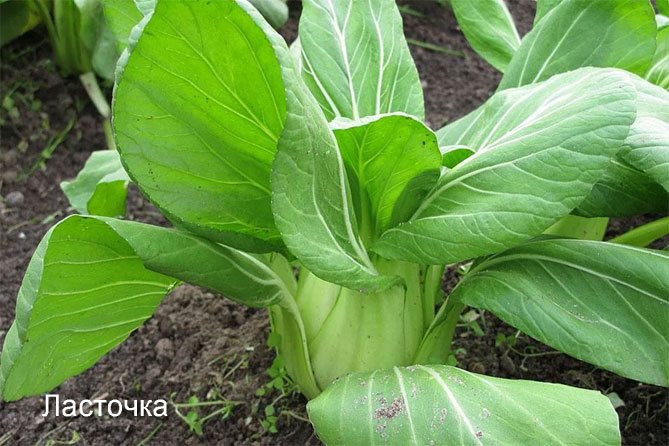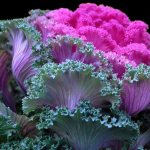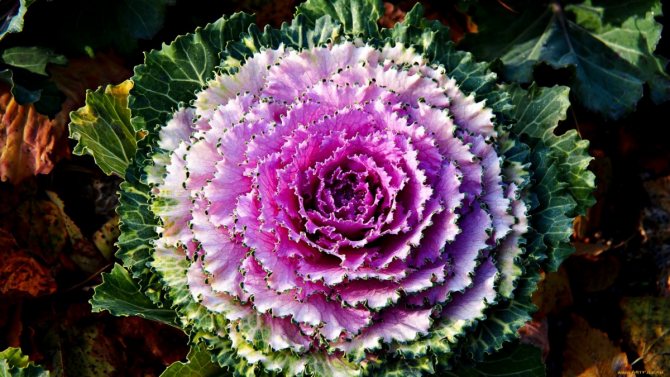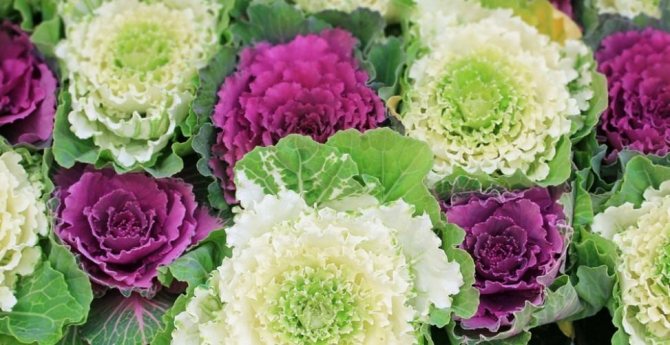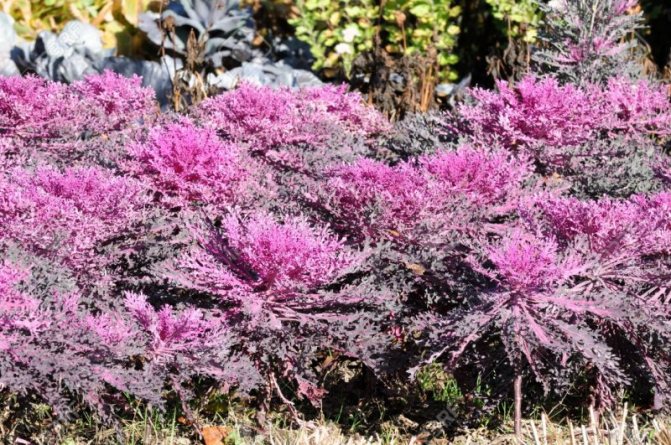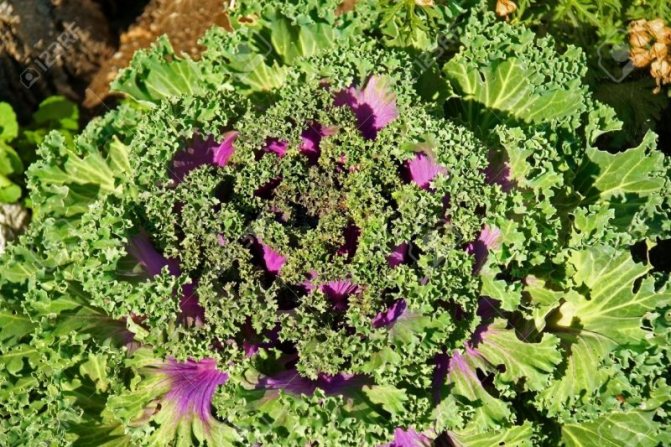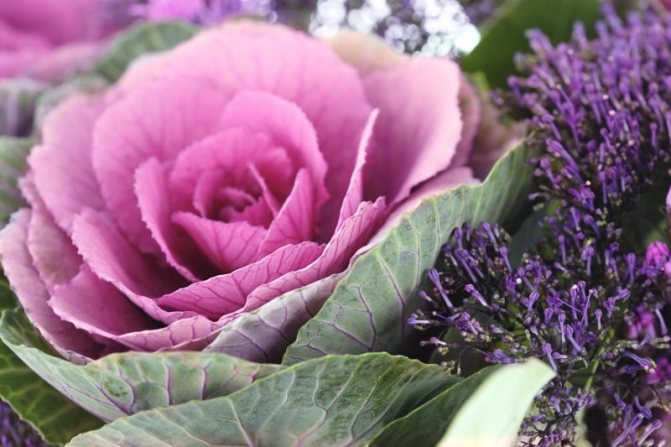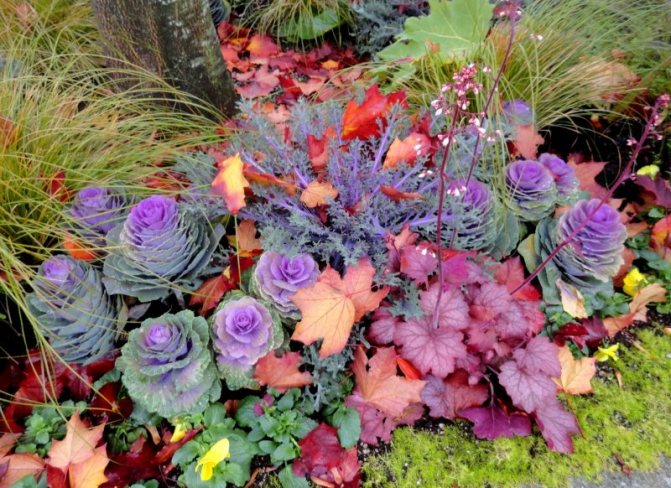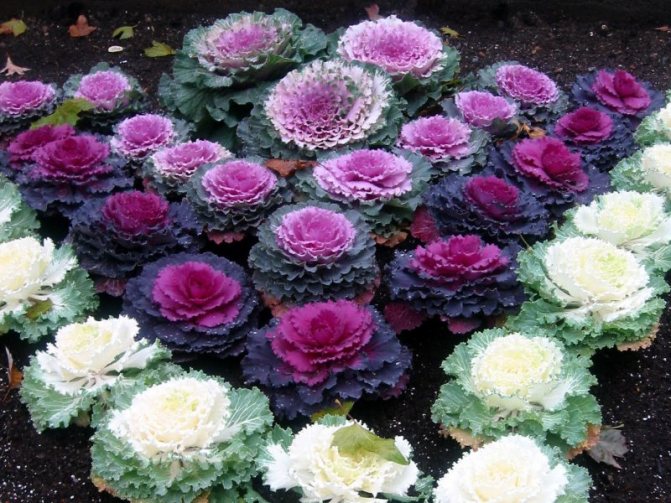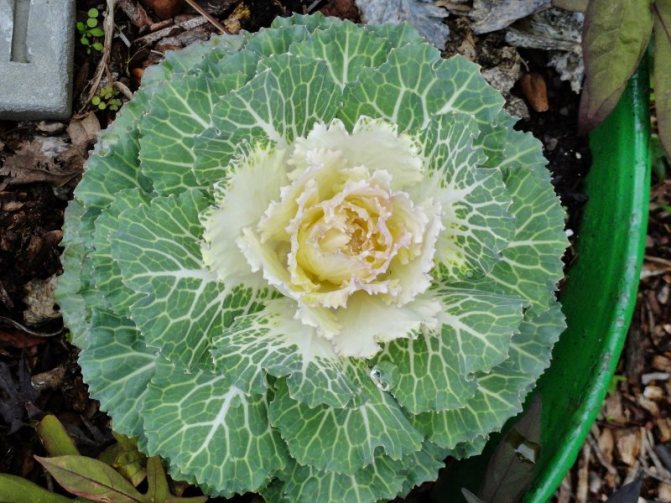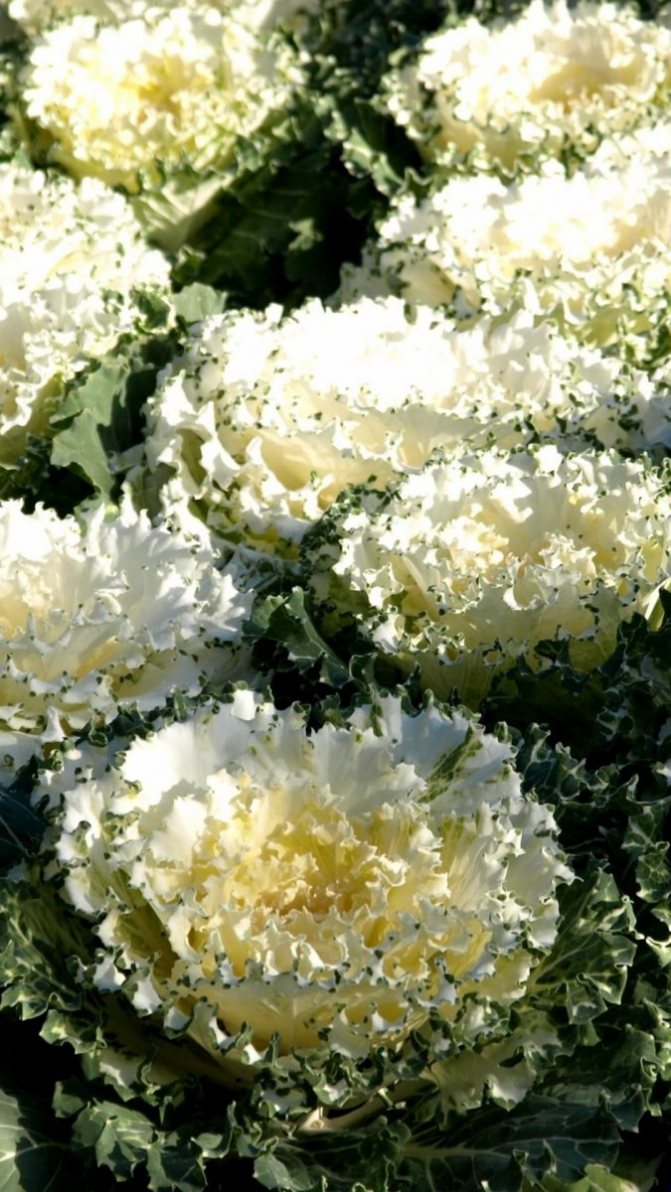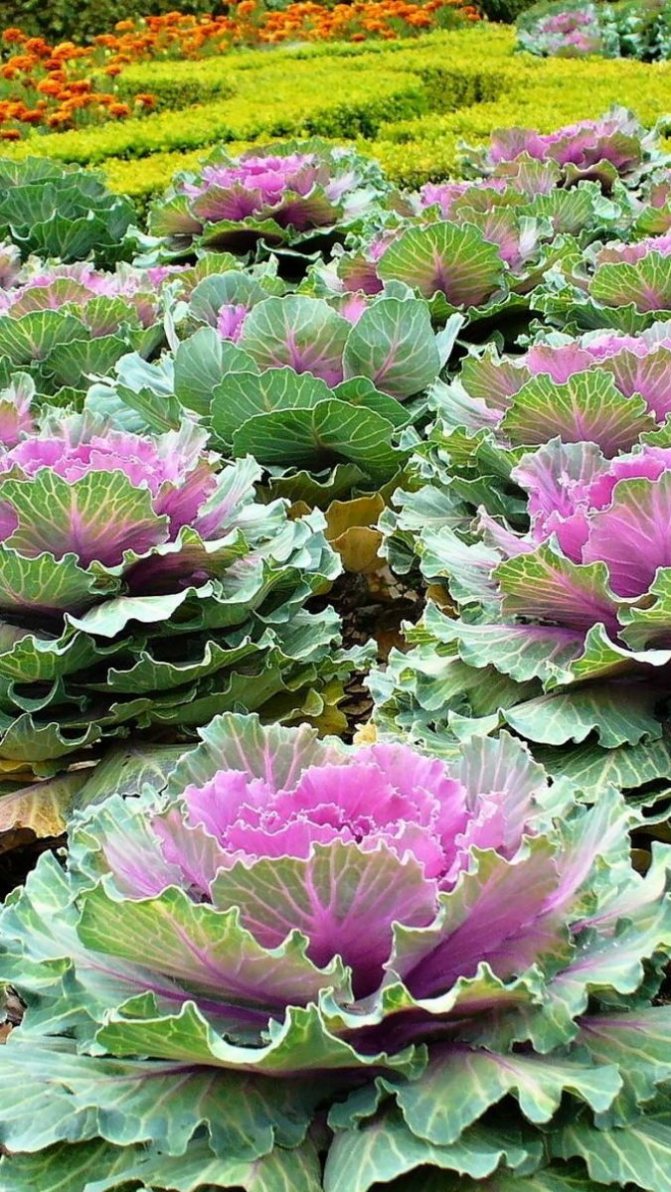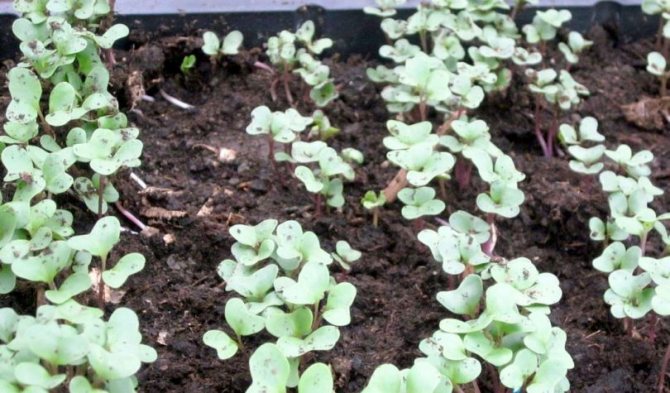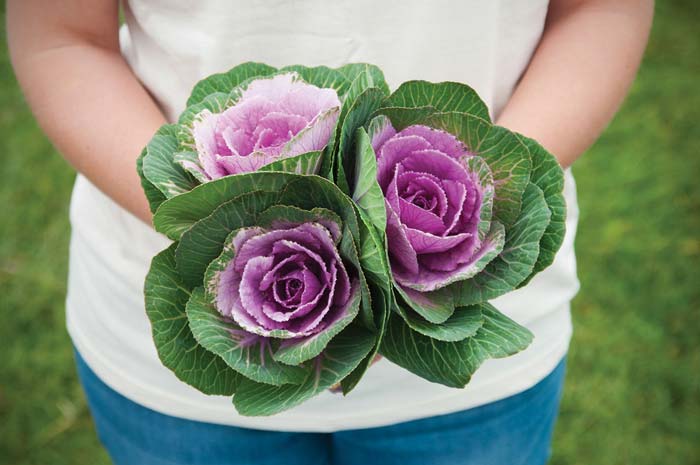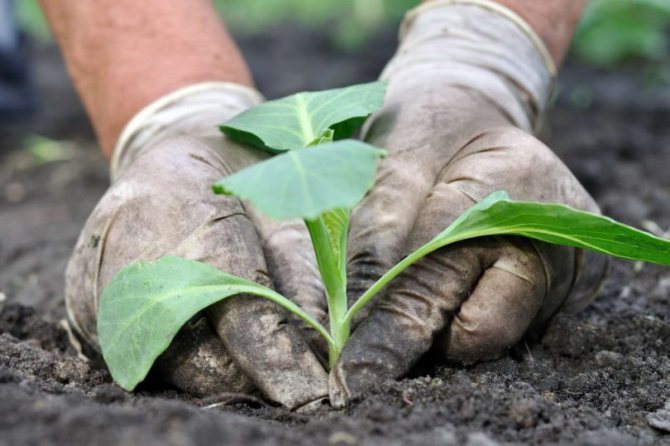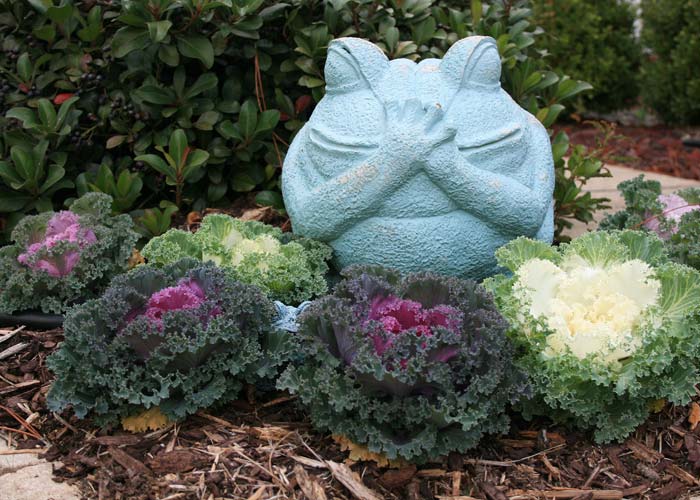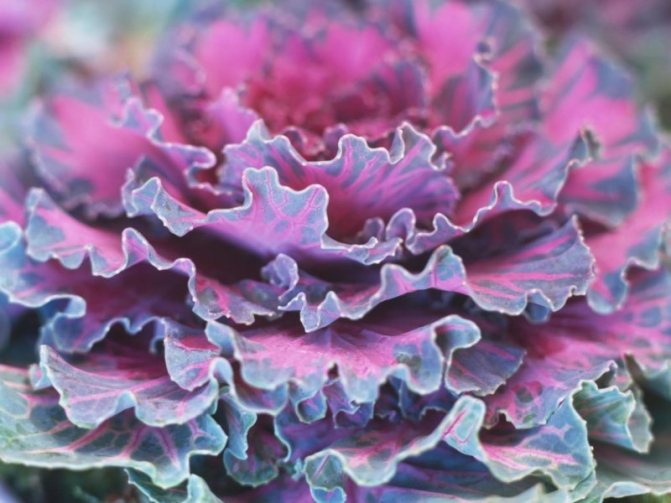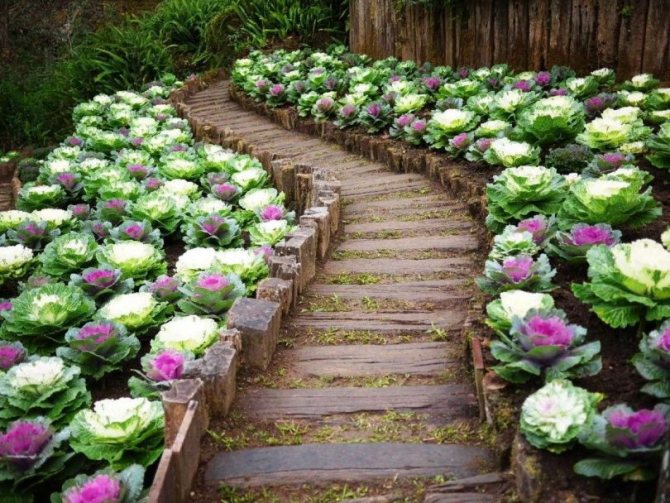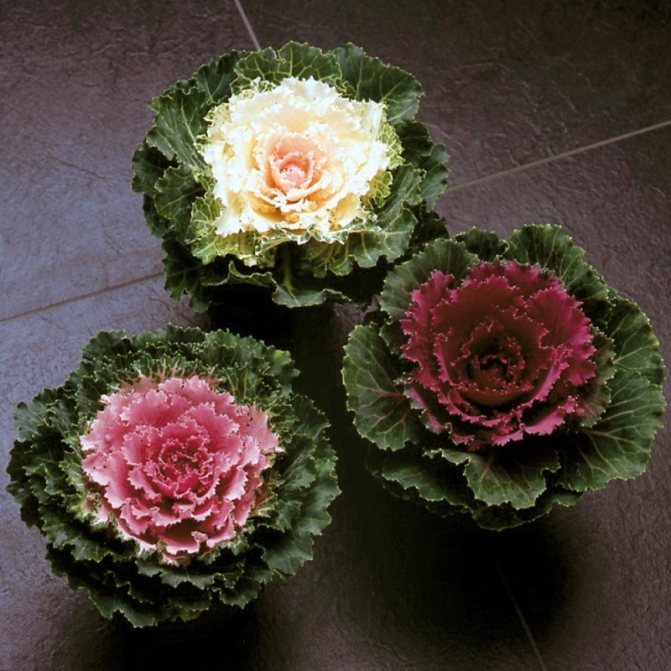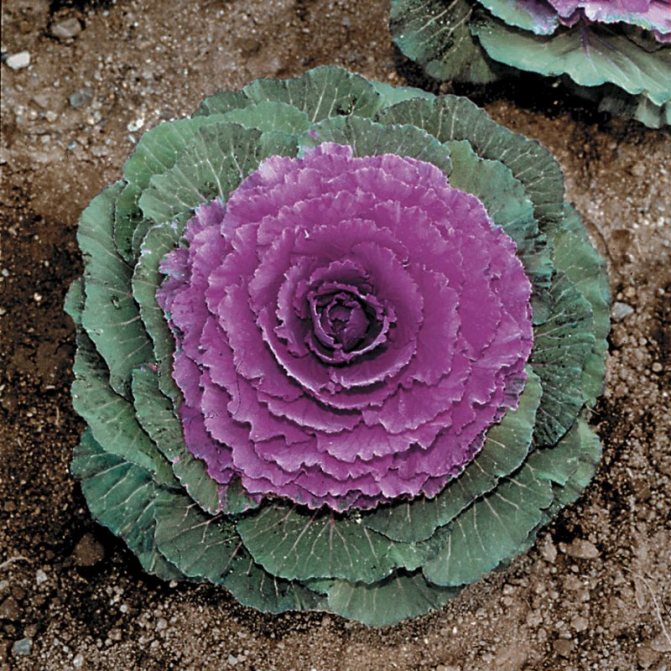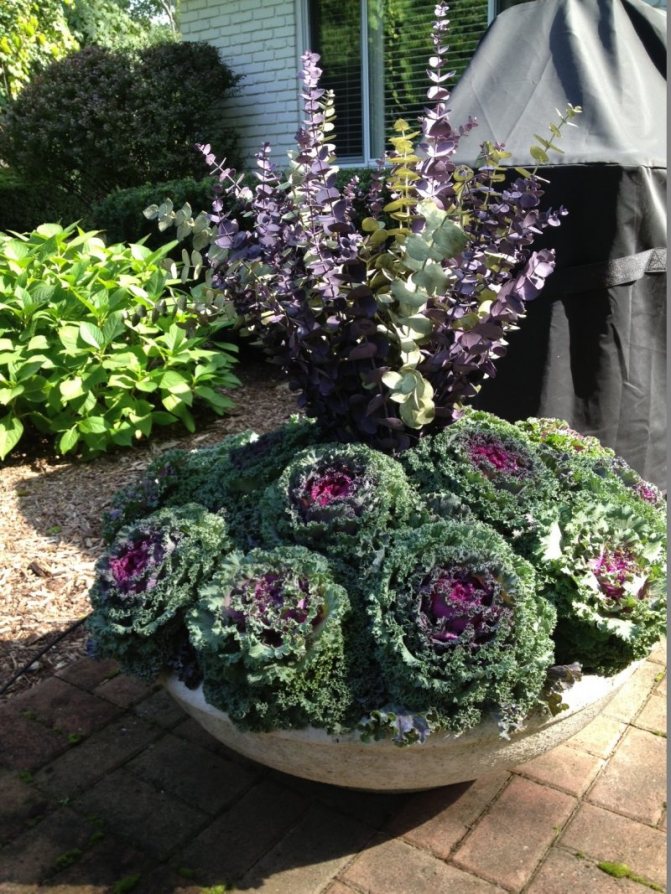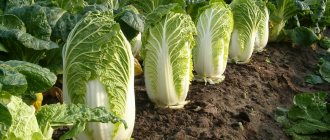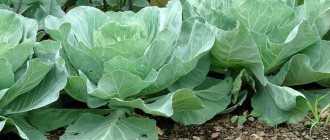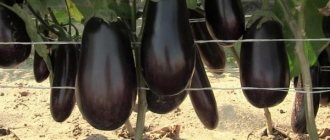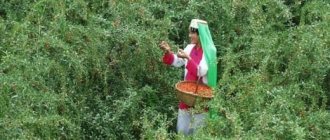Ornamental cabbage is one of the favorite plants among hobby gardeners because it is easy to grow, easy to care for, and amazing to look at. This plant has earned itself fame in landscape design. Today you will get acquainted with ornamental cabbage in more detail, and you will also be able to learn all the intricacies of its cultivation in the open field (planting, care, advice). A detailed photo instruction is attached.
Description of ornamental cabbage
Ornamental cabbage (brassica), classified as garden cabbage, headless variety (Brassica oleracea var.acephala), belongs to the Cruciferous family. It is edible, just like its "sisters": white, colored, Savoy, etc. This leafy variety has a valuable chemical composition and can be an excellent vitamin supplement. After the first autumn frosts, brassica leaves lose their bitter taste and become very tasty.
Fresh articles for gardeners, gardeners and florists
Hippeastrum transplant at home
Transplanting chrysanthemums in the fall to another place
When to dig up lilies for transplanting in the fall?
How to transplant an adult thuja to another place?
In our opinion, this culture should be given a different role in the summer cottage. Its lush leaf rosette, colored in bright colors, retains its extraordinary decorative effect until winter and withstands frosts down to -12 ° C. And when all the other annual crops have long been resting in the compost heap, brassica continues to show off on the site, raising the mood with its spectacular outfit and transforming the dull landscape of the autumn site. Therefore, it is better to plant it not in the garden, but in the garden and flower garden.
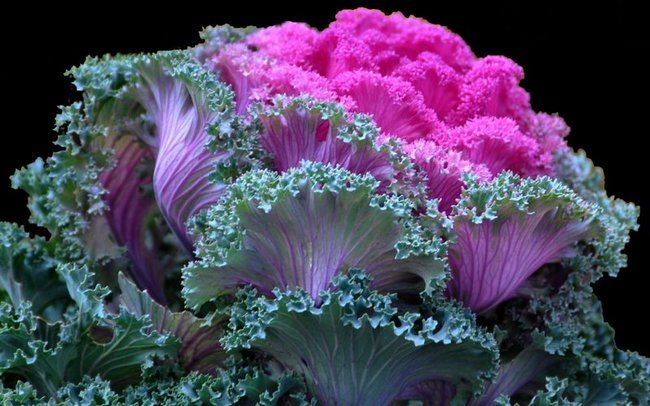
Disease prevention and pest control
Enemies of pink cabbage are fleas, slugs, caterpillars. The first ones can be washed off from a spray bottle and the damaged ornamental plants can be powdered immediately after that with ash, tobacco or red pepper.
Also read: Features of autumn garden flower care
Sprinkling the earth with needles or eggshells helps with slugs. The neighborhood of cabbage with marigolds is decorative and useful, because butterflies hate them. Caterpillars and snails have to be harvested by hand or sprayed with Aktara (1 g per bucket), Thunderstorm or Meta.
Prevention against fungal disease "black leg", from which the seedlings suffer, is watering cabbage plantings in moderation (better - spraying). In an extreme case, you have to resort to spraying with aktyllik.
Ornamental cabbage Pigeon Victoria
This variety is also not particularly tall - 35 cm flower maximum. The sheet plate is quite dense, has a wavy shape. The color changes as it approaches the center: from green along the edge, then milky and closer to the middle of pink. The hybrid was bred by Japanese breeders.
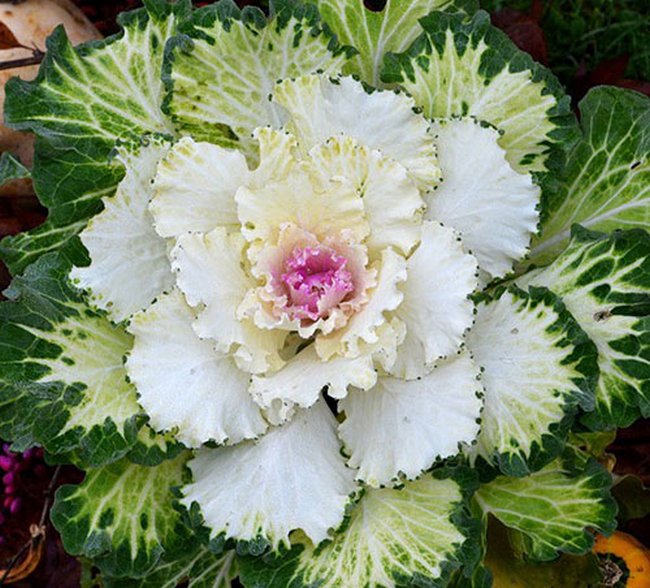

Seeds
Reproduction in cabbage occurs by seeds, so in the second year of life you can collect them. In the autumn, cabbage is uprooted from the ground, leaves are removed from below and buried in the sand until spring. Vegetable outlets are stored in a ventilated and dry place.
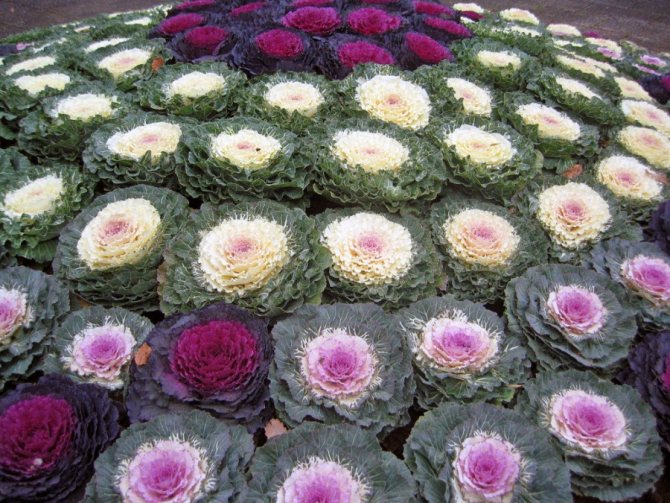

With the onset of warmth, the plant is again planted in the garden.For better pollination, plants need to be planted closer to each other.
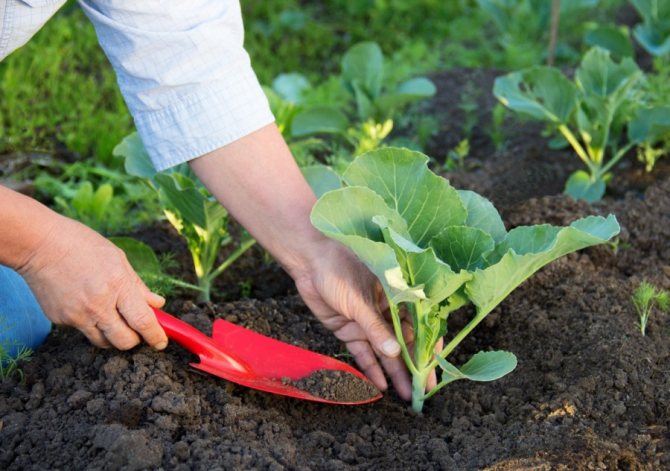

In June, strings appear, in which seeds will appear by November. They can be eaten by birds and should be covered with a cloth to preserve them. When the pods are dry, they are cut and tied, then they are shelled.
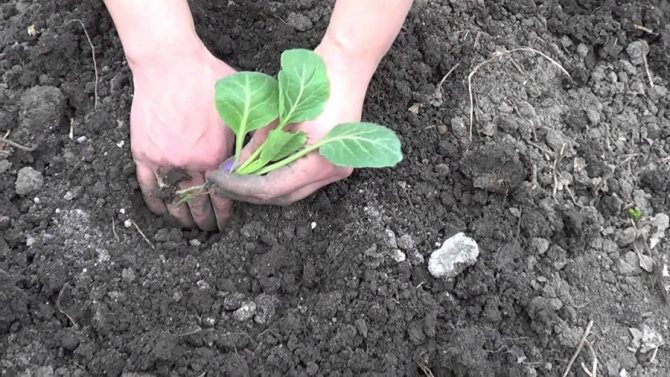

If you want to harvest seeds, then know that only the best plants are needed for this.
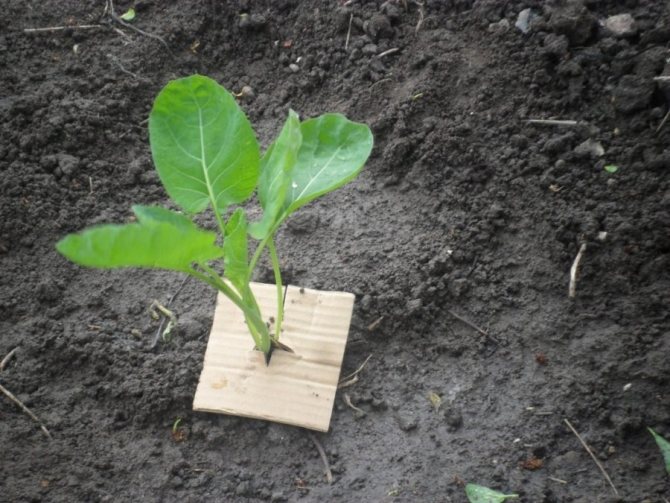

Ornamental Cabbage Princess
It is an annual plant that grows up to a third of a meter tall with a dense rosette of green, yellow, dark or light corrugated, serrated leaves. The decorative coloration appears from August.
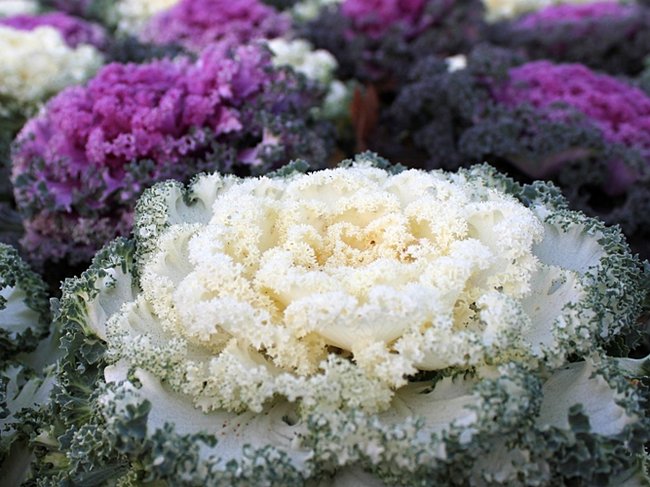

Fresh articles about garden and vegetable garden
Aspirin for indoor flowers
Astra: sowing seeds for seedlings
Astilba growing and care photos
Vyacheslavna
It resembles the previous variety in shape and size. But the color of the middle is creamy, and the outer "petals" are grayish-green.
East colors
Low grade with leaves spreading half a meter. Intense color appears in mid-autumn. The color range varies from light green to purple. Disease and frost resistant.
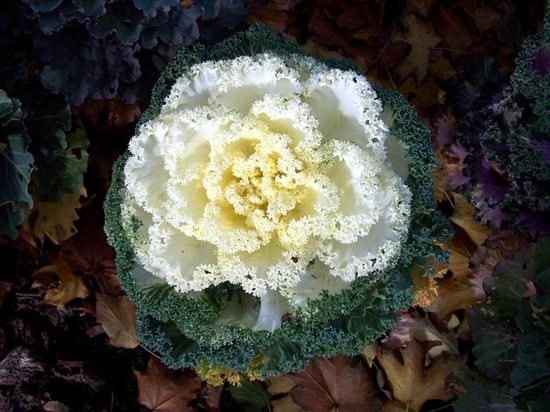

Ornamental cabbage Vyacheslavna
Lace mosaic
Its highly corrugated leaves are white, green or purple in color. Decorativeness begins by the end of summer.
View of Nagoya
Reach half a meter in height, the leaves are lacy and light green on the outside. And the flower-like middle, depending on the type of hybrid, is cream, purple or pale pink.
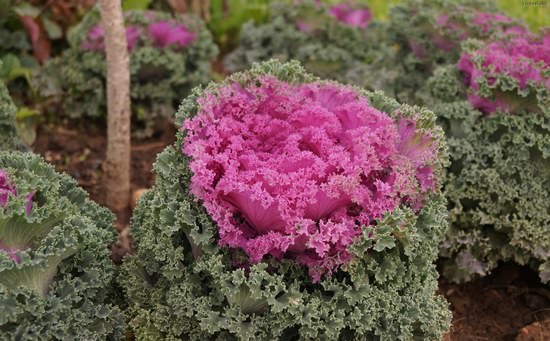

Ornamental cabbage Nagoya
Osaka views
Plants with a dense rosette of wavy leaves of bright or pale green outside and in the middle of different shades of pink or red. Coloring is determined by the type of hybrid.
Russian circle
Low grade with oval leaves of snow-white, pink or dark purple color. They retain this decorative appearance for at least 4 months.
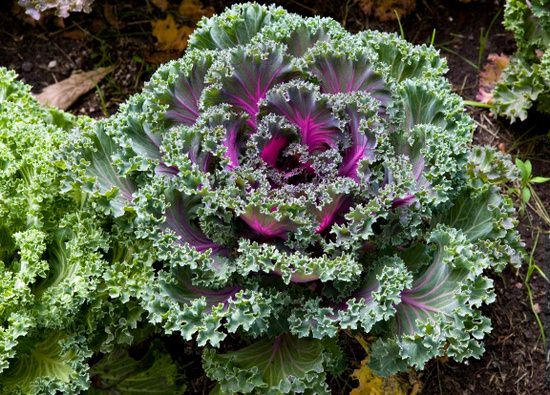

Osaka ornamental cabbage
Firework
Low appearance with the original shape of the outer burgundy, narrow and long leaves with a red, flower-like middle.
Turtle
Dense inflorescences of bright green color, structure similar to cauliflower.
Ornamental cabbage Assol
The plant is of medium late maturity with a compact rosette of leaves up to 45 cm in diameter. It reaches a height of small size - about 35 cm. The rosette is colored light green at the edges. To the center of the flower, the color smoothly turns into yellow-white. Plants show resistance to pests and diseases. Coloring may appear even without exposure to low temperatures.
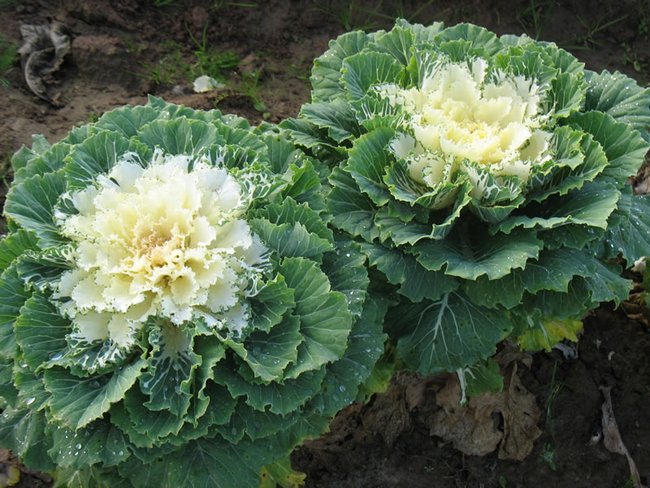

Growing seedlings
For a good harvest, it is advisable to know when it is best to plant the plants in your area. If transplanted later, the plant will grow worse. How the cabbage will grow and develop depends directly on the quality of the soil.
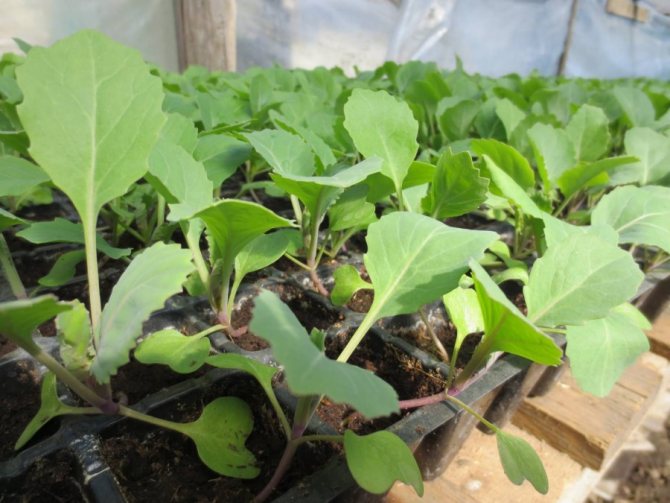

Seeds are sown into the soil by 1.5 cm. After 2-3 leaves appear, the seedlings are planted separately. In open ground they are seated 3 cm from each other.
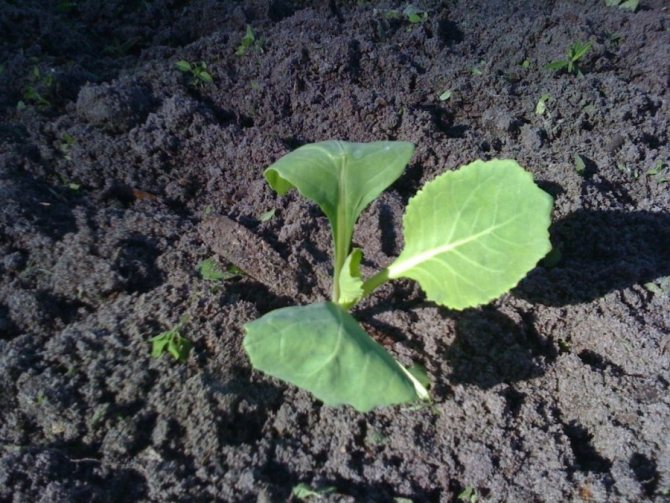

The main thing is to water, weed and feed during the time. It is recommended to water the cabbage early in the morning or in the evening, while there is no bright sun. Once every 7 days, after watering, it is recommended to loosen the soil. Watering should be done daily during drought.
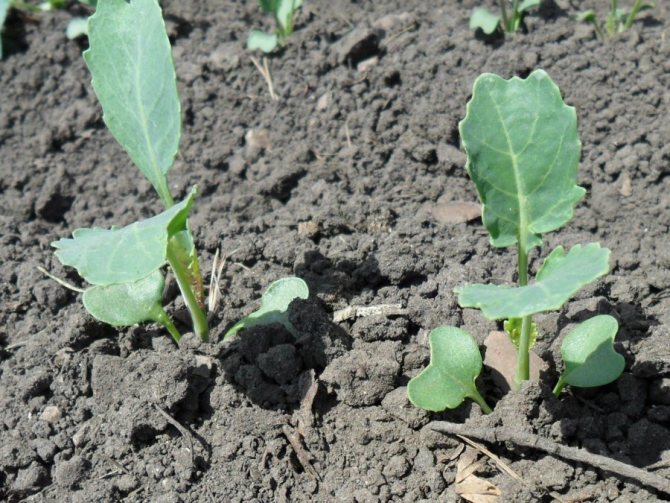

For best growth, weed seedlings should be weeded. Once every 10 days, it is recommended to fertilize the cabbage with mineral fertilizers.
You cannot add manure to the soil. If properly cared for, the plant will bloom from July to early November. Ornamental cabbage will not lose its appearance even at low temperatures.
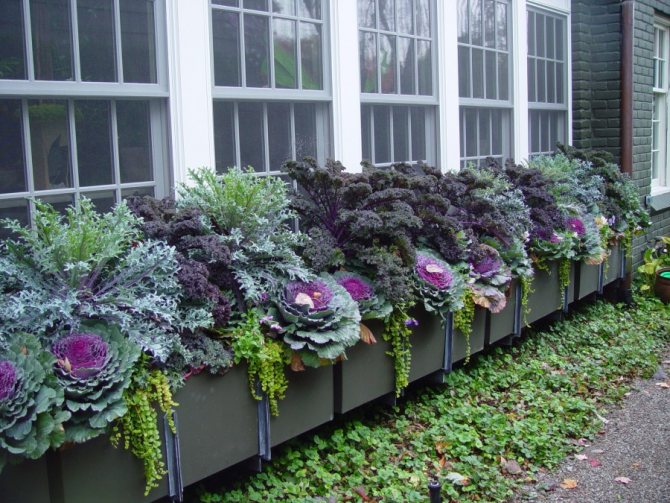

Osaka ornamental cabbage
These plants are very similar to the representatives of the Tokyo group, but grow slightly taller (up to 55 cm). The structure of the head, curliness and shades of leaves are practically the same in both series.Ornamental Osaka cabbage also comes in different varieties: Osaka Pink (pink), Osaka Red (burgundy red), Osaka White (white).
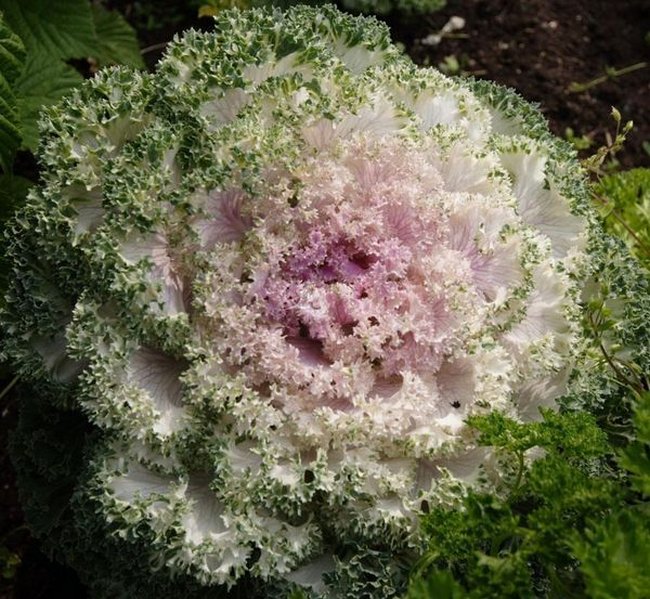

Growing
If you get good yields of white cabbage in your garden, then when growing brassica you will have absolutely no problems - their agricultural technology is very similar. But even novice summer residents should definitely pay attention to ornamental cabbage. This plant is completely unassuming to care for and will require a minimum of knowledge and skills from you.
Landing
Young shoots of brassica at the initial stage of growth require coolness, so the easiest way is to sow the seeds in a greenhouse or under a film shelter on the site in mid-April, and then plant the seedlings in the right place. If you need to get lush rosettes early, this crop is grown at home, sowing in mid-March.
Ornamental cabbage can be sown directly into open ground
To do this, pre-soaked seeds are sown in a pre-prepared container filled with a loose fertile substrate. Such a soil mixture can be purchased at a store or prepared independently by mixing in equal proportions leafy soil, humus, peat and river sand and adding a couple of glasses of sifted wood ash to a bucket of such a composition.
To avoid subsequent picking, it is easier to immediately plant ornamental cabbage in separate containers - cups or cassettes. With this approach, 2 seeds are placed in each cell, deepening them by 0.5-1 cm, and after the emergence of shoots, a weaker sprout is removed.
Brassica seedlings in cassettes
Before the emergence of seedlings, the containers are provided with a temperature of + 18 ... + 20 ° C (in such conditions, the sprouts appear in 3-5 days), and then the regime is changed. In the first week, seedlings are kept during the day at a temperature of + 10 ... + 12 ° С, and at night at + 6 ... + 8 ° С. In the future, the daytime temperature is maintained at + 13 ... + 16 ° С, and the nighttime temperature + 8 ... + 10 ° С. After the emergence of seedlings, the seedlings are rearranged on the lightest window sill, but in cloudy weather, as well as in the mornings and evenings, the plants are additionally illuminated with fluorescent lamps.
The soil must be kept moderately moist at all times. During the period of home stay, it is good to feed the plant a couple of times with any complex preparation according to the instructions. This is done 10-12 days after germination and again 12-14 days later. Seasoned seedlings are planted in open ground at the end of April or in May (depending on the region).
Seedlings are planted in the ground at the end of April or in May
This culture, unlike its closest cabbage "relatives", tolerates transplanting much better. Therefore, seedlings can be planted immediately on a permanent place or on a separate bed in the far corner of the garden, and in the second half of summer, adult plants with a large lump of earth can be transplanted to a flower bed.
Brassica tolerates a little shade, but it turns out to be more effective if it grows in the sun, so it is better to plant it in an open area. It is also worth taking care of the composition of the soil in the garden. It must be generously fertilized with humus or compost (about a bucket per 1 m²), add any complex mineral preparation according to the instructions, and if the soil is acidic, be sure to add wood ash for digging (up to 0.5-0.6 kg per 1 m²). Ash, as well as dolomite flour, can be added as a deoxidizer in spring, but fluff lime must be embedded in the soil since autumn.
Seedlings are planted in the wells by transshipment from glasses. Photo from the site
Seedlings are trans-shipped from glasses and planted in holes staggered at a distance of 30-60 cm from each other (depending on the variety). The plants are buried in the soil up to the first leaves, the soil is compacted around them and watered abundantly.
Brassica, like all members of the Cabbage family, is very hygrophilous.Therefore, if you want to get lush rosettes, do not leave this crop without watering - the soil under it should be constantly, but moderately moistened.
To protect the plant from damage by fungal diseases, watering must be carried out with settled water heated in the sun. In addition to watering at the root, pamper ornamental cabbage with sprinkling from a watering can - she loves to "swim" very much.
Ornamental cabbage is very hygrophilous
In order to reduce the amount of watering, the soil under the plants can be mulched with any available material - dried weed after weeding, straw, rotted sawdust, shavings, etc. A layer of mulch on the garden bed will also keep weeds at bay and save you the trouble of loosen the row spacing after each dampening.
Planting ornamental cabbage from seeds
It is better to sow the so-called flower in mid-spring. In small containers, no more than 5 cm in diameter, spread 2 seeds each and lightly press into the soil, which had to be treated with a fungicide in advance, to prevent the disease of a young plant. The optimum temperature for the emergence of the first shoots is approximately +20 ºC.
The most common way of breeding a plant is to grow it with seedlings, which can be sown both in small containers or under film in greenhouses, and immediately into open ground.
Subject to the basic conditions, the appearance of the first shoots can be expected after 2-5 days. After the first seedlings appear, you can transfer the young seedlings to a place where the baude temperature is slightly lower. Now do not forget about constant moderate watering. As soon as the appearance of another leaf becomes obvious, there is a need for light feeding. And when the plant already has 4-5 leaves, this is evidence that the plant is ready for planting in open ground. At the same time, there is no need to plant the plant immediately on the flowerbed, since it will reach full bloom by the fall, so you can temporarily grow it in the garden.
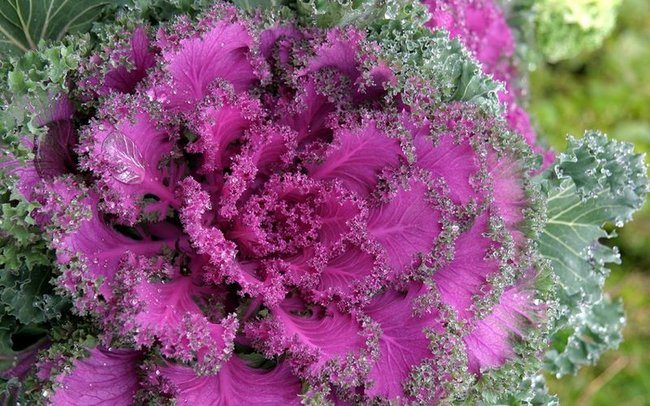

The disembarkation is carried out in several stages:
- Pre-prepare a bed, make holes with an interval of 25-40 cm and add 15 g of ash or 5 g of ammophos to each.
- The seedlings, together with a moist earthen clod, are removed from the container and placed one by one in the holes.
- Sprinkle the plants with earth until the cotyledon leaves and watered them.
- It is advisable to land in the morning or in cloudy weather. In the early days of the seedling beds, you need to shade with a white non-woven material.
Fresh articles about garden and vegetable garden
Pepper seedlings do not grow, stands still, what to do?
If the seedlings of cucumbers are very elongated, what to do?
Planting peas in spring sowing: when to sow, how to plant correctly?
Variety of varieties
Ornamental cabbage has been known to man since the 4th century AD. e. Already at that time, she attracted the attention of admirers of natural beauty. Today, various breeding companies are engaged in breeding and obtaining new varieties of this vegetable. Farmers are offered a huge varietal variety of ornamental cabbage, which includes improved varieties with a spreading rosette resembling a palm tree, and beautiful, primordially decorative varieties with a closed, classic rosette, round in shape.
Palm varieties
Domestic breeders more than half a century ago brought out a number of forage cabbage varieties, which have been improved over time and are today used to decorate flower beds, lawns, and gardens. As a rule, such plants are quite tall, have several long petioles and curly leaves.
Lark tongue
This cabbage does not at all look like a white-headed "relative" familiar to many. It forms the main stem with a height of 50 to 130 cm. On it there are a large number of petioles up to 20 cm long. The leaves of this decorative "beauty" are curly, rather large. Their coloration is green. The Lark Tongue variety is grown from early spring to late autumn.In the second half of summer, the vegetable grows and shows all its decorative qualities.
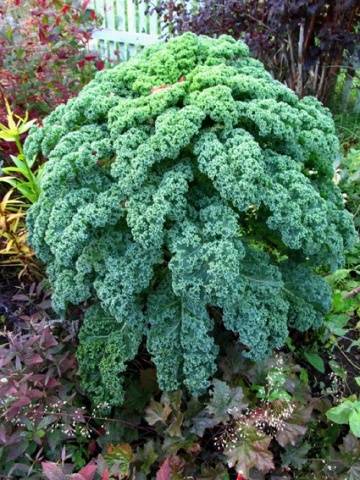

Red curly
Florists and landscape designers are offered two varieties of kale. These are the varieties "High red curly" and "Low red curly". From the name it is clear that these two species differ in plant height. Low cabbage does not exceed 60 cm in height, high grows up to 130 cm.The leaves of these varieties are spreading. The diameter of such a plant reaches 1 m. The color of the decorative culture is dark purple.
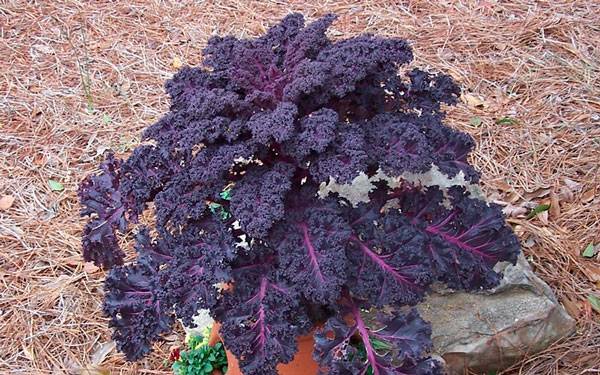

Kai and Gerda
This variety is represented by ornamental cabbage in two colors at once: green and emerald. The height of adult plants "Kai and Gerda" reaches 50 cm. Their leaves are amusing, elongated with curly edges. You can grow such a decorative vegetable in a sunny area or in partial shade.
Kale red
This wonderful cabbage has not only excellent decorative properties, but also benefits for the human body. It contains 9 essential and 18 nonessential amino acids. In terms of the amount of protein, it can surpass meat. "Kale red" also contains vitamins of group B, PP, K, C and a complex of minerals.
It is not difficult to grow such a healthy cabbage on your plot or flower bed. At the same time, the leaves of a beautiful, curly plant, up to 1 m high, have a pleasant, fresh, sweetish taste.
The above decorative varieties of cabbage are spreading and massive, therefore they are rarely used as an independent design element. More often, such varieties in a flower bed are supplemented with other ornamental plants.
Cabbage with a closed rosette
Ornamental cabbage with a closed rosette looks original and interesting on the flower bed. The variety of such varieties allows you to choose a vegetable with leaves of the required color to compose any floral arrangement.
This variety is highly decorative and resistant to adverse weather conditions, frost and other troubles. Cabbage leaves are densely arranged, forming a beautiful "basket". The edges of the leaves of the "Nagoya" variety have strongly curly edges. Their color is combined: the lower leaves of an ornamental vegetable may be green, and the inner leaves may be red or white. Plant height up to 60 cm. You can see a photo of such an original cabbage below.
Read also: Planting plums in the spring: how to plant plums with seedlings in open ground, step-by-step instructions for different regions


Cabbage variety "Tokyo" is a low plant up to 35 cm. Its leaves are rounded, with slightly curly edges. The color of the leaves is combined: the outer leaves are colored green, the inner ones can be white, red, pink. It is this kind of ornamental cabbage that can often be seen on flower beds and lawns. It is used to frame tracks.
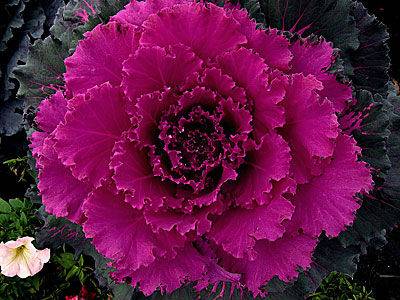

Cabbage variety "Piglon" has very interesting rosettes, resembling roses in appearance. The leaves of this ornamental plant are oval with perfectly smooth edges. Their color combines 3 colors at once: green, cream and pink. The height of the cabbage does not exceed 30 cm. You can see such a unique plant in the photo below.
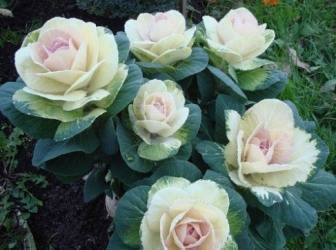

Coral Queen
This variety is the opposite of the Piglon variety: the Coral Queen leaves are very dissected and look like corals. The height of such a cabbage does not exceed 20 cm, while the diameter of the rosette can reach 30 cm. The outer leaves of the ornamental vegetable are purple, the inner leaves are crimson.
In addition to these varieties, the decorative ones are "Osaka", "Princess", "Mosbakhskaya", "Colors of the East" and some other types of cabbage. So, picking up various varieties of decorative vegetables in height, color, leaf shape, you can make an original composition. At the same time, the Kale red variety can become not only a unique decoration, but also a tasty, healthy treat to the surprise of family and friends.
Outdoor ornamental cabbage care
For seedlings in open ground, care is the same as for seedlings: water, feed. Remember to water the cabbage regularly and well. The upper 30 cm of the earth under the bush should be saturated with water. Sprinkle over the leaves in hot weather. Splashes of water will also serve as a pest repellant. Keep the aisles loose and free from weeds.
As for dressing, over the whole summer it is enough to make two or three infusions of herbs, droppings or mullein, that is, once a month. If you overfeed ornamental cabbage with nitrogen, then the leaves will be large, juicy, but will not acquire bright colors. Green color will prevail. At the end of August and September, it is better to feed it only with ash: powder the earth and loosen it.
Simple care tips
It is no secret that proper timely care is the key to success. And although the plant is not particularly whimsical, nevertheless, this part of the cultivation should not be ignored. Moreover, caring for ornamental cabbage does not require painstaking efforts. The main requirements are regular abundant moisture, loosening of the soil, getting rid of the plant from harmful weeds. Due to the unusual structure of the structure (volumetric rosette), the culture needs hilling, which will help strengthen the root system and increase its stability. The plant will not need additional fertilization if the soil has been properly prepared before planting. If not, then you can feed it even when the cabbage is planted in a permanent place, about 15 days after. The next time you can fertilize after two weeks. The solution and dosage can be used the same as for planting.
Planting and caring for ornamental cabbage (video)
Ornamental cabbage in landscape design photo
Due to its luxurious appearance, ornamental cabbage has found its application not only in the garden plot, but also in landscape design. It is especially actively used to decorate gardens, flower beds and other flower plantations from late summer until late autumn, since the plant feels comfortable even in an "inhospitable" climate: it is not afraid of torrential rains and even frosts (cabbage is quite viable when outside around 5 degrees below zero.
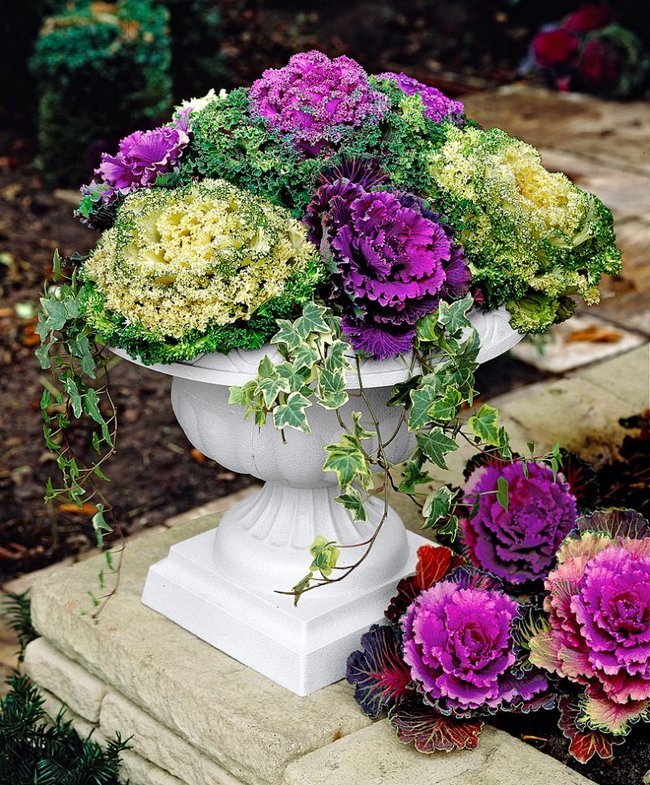

Ornamental cabbage looks interesting in containers (tubs, flowerpots, containers). Containers made of any materials, including ceramic, are suitable, but monumental tubs and flowerpots look best: for example, wooden ones. With the onset of severe cold weather, plants can be brought into the premises, which will significantly extend their life. Many varieties remain decorative until December. Of course, miniature varieties, such as varieties from the Crane series, are best suited for the home.
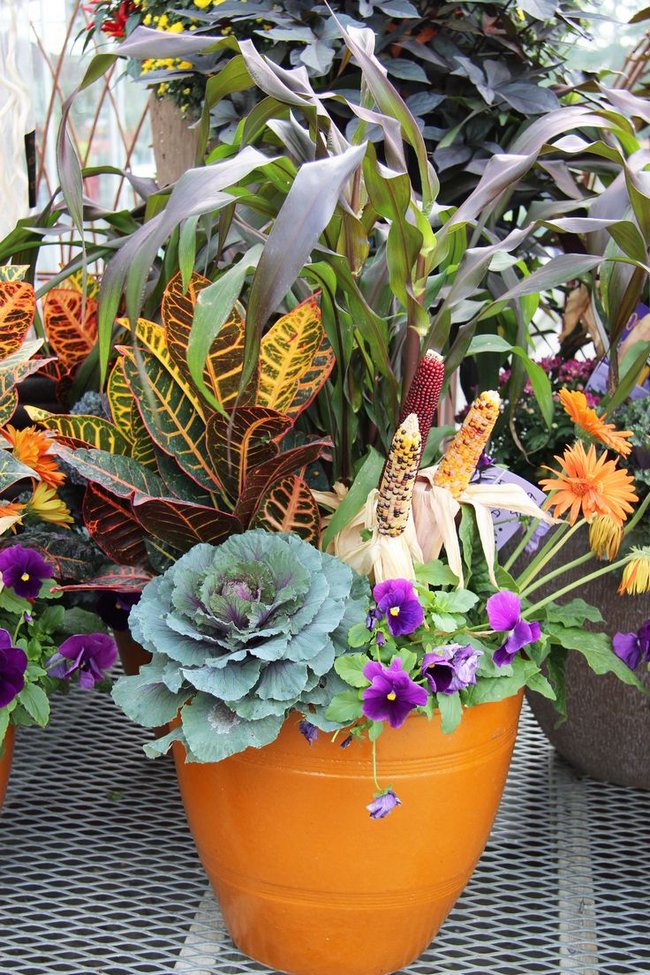

Application
At the moment, ornamental cabbage is inferior in popularity to many flower crops. But we can say with confidence that this phenomenon is temporary, since its unpretentiousness in care and cultivation, as well as flowering and a beautiful fresh appearance until late autumn, are preferential conditions, making it the primary plant in any autumn flower bed. Ornamental cabbage in landscape design is used both independently and in combination with many other flowers. And for long-lasting flowering, it can be transplanted into some container and transferred to home conditions.
Ornamental cabbage can be eaten. Although its taste is somewhat different from the usual variety of garden cabbage, the presence of bitterness. However, this problem can be solved by freezing the foliage before cooking.
Nevertheless, most will agree that everything has its place: ornamental cabbage - in the flower bed, and white cabbage - in salads!
Pests of ornamental cabbage
Ornamental cabbage is grown in the same way as ordinary cabbage: seedlings are grown, planted, watered with warm water, and weeds are removed. Some problems like "I can't grow it in any way" are practically excluded. It is because of its unpretentiousness and vitality that ornamental cabbage is used in landscaping city streets and parks. But it is worth remembering one sad circumstance: ornamental cabbage does not grow on sandy soils. That is, it does not grow so much that, perhaps, it is not even worth the effort.
Another difficulty in growing ornamental cabbage is that it is a favorite food for caterpillars and slugs. To combat pests, users of our portal use special means, not only biological products - but then you need to treat the plant exactly as a decorative one, and forget that it is still edible. From caterpillars watered with "Iskra", "Aktara" has shown itself well - it is only recommended to start processing early, before the beginning of summer of butterflies, "Fitoverm"; sand is poured from slugs around the beds from cabbage.
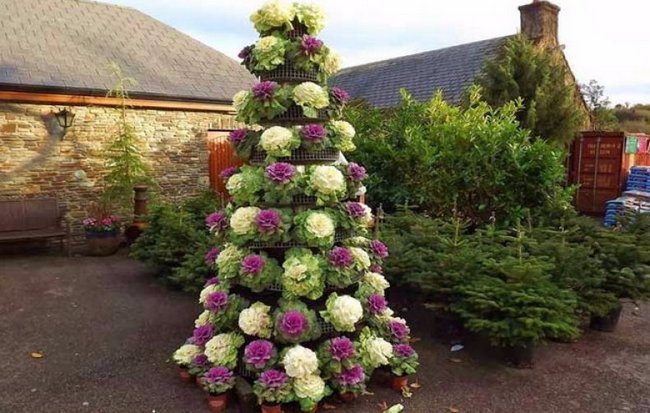

Ornamental cabbage is gaining popularity among gardeners. It is easy to grow it, and its care is not difficult. Decorate your flower beds with these luxurious and unique "huge roses" and "palms". May they delight you until the snow.
A bit of history
The historical roots of ornamental cabbage go back to the days of Ancient Greece. It was in this corner of our planet that already at that time they were engaged in the cultivation of this amazing plant. She was also known on the Balkan Peninsula, where there was a special attitude towards her, since there was a belief that drops of sweat of the god Jupiter served as a stimulus for her growth.
Later, the whole of Europe learned about the miracle cabbage. A significant contribution was made by the distant country of Japan, where breeders have worked hard to develop new varieties. Eventually, by the middle of the 18th century, more than ten different varieties of the plant were developed. Wealthy owners of estates could use it as decoration for their wealthy estates.
As for the Russian residents, they are practical people, and therefore they preferred to grow ordinary cabbage, white cabbage, and not decorative.
Reproduction
Ornamental cabbage propagates only by seeds, but the plant should not belong to hybrids. The seeds of hybrids collected at home do not retain their color and decorative characteristics. The harvested seeds can be stored for 5 years.
High-quality seed of hybrids can be purchased from companies:
- Gavrish;
- Russian vegetable garden;
- Aelita;
- Search;
- SeDec.
What is ornamental cabbage, how to sow it, take care of the flower bed and fight pests, you can find out while watching the video:
Color
An annual cabbage, especially popular among gardeners. It is considered a dietary product and indicated for a healthy diet. Represents multiple stem-shaped buds with dense double tops of greenish or yellowish colors. Cauliflower contains many vitamins and minerals, among which you can find: vitamin A, B1, B2, B3, B5, B6, B9, C, E, K, fiber, beta-carotene, potassium, magnesium, sodium, iron, manganese , calcium, phosphorus, zinc, copper, fluorine, iodine, chlorine.
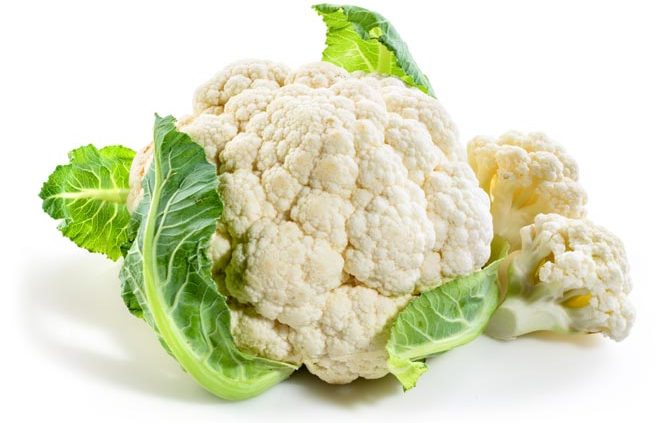

The culture steadily tolerates a drop in temperature to -10 ° C, but at the same time it does not form inflorescences well. The species does not tolerate drought and heat.
This species has some features of cultivation agrotechnology:
- loves enriched loose soils;
- there is a need to protect the heads of cabbage with leaves from direct sun exposure, then they retain their snow-white and freshness.
The most popular varieties of cauliflower are:
- Snowball (Snow Globe),
- Express Ms,
- Yoke,
- Maybach,
- Alpha,
- Parisian.
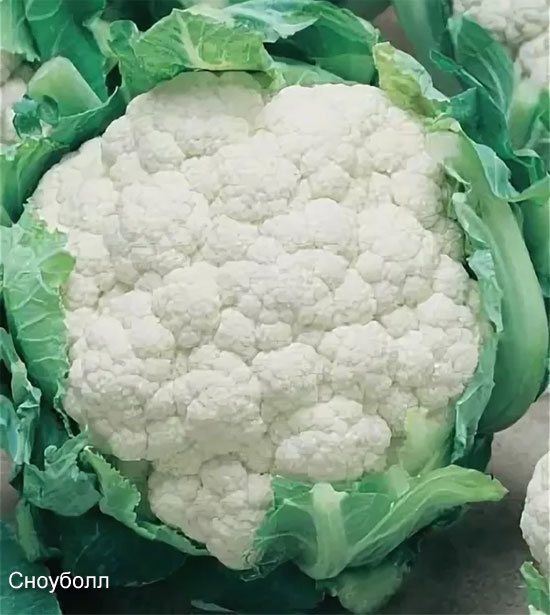

- Maybach F1 is an ultra-early hybrid with a growing season of 50 days. Heads of cabbage are round-flattened, white, weighing 1.0-1.2 kg, dense.
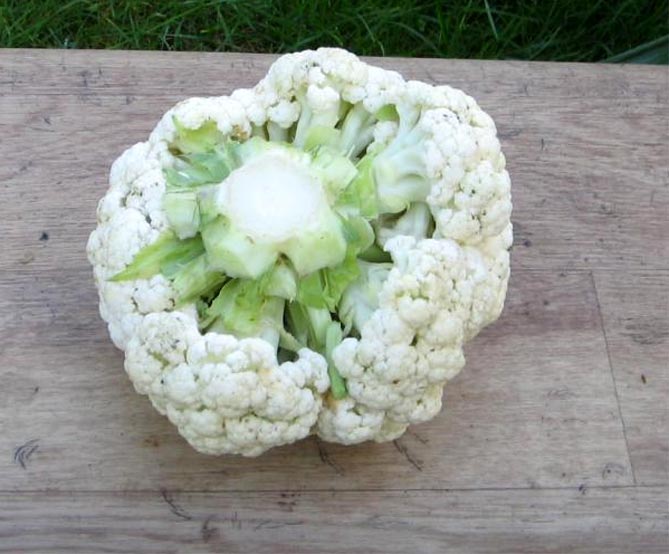

- Snowball is a moderately late variety intended for autumn harvest.Creates white, large, heavy heads of cabbage, resistant to pinking, weighing about 1.30 kg. Fertile soil required. The variety is intended for direct consumption and processing.
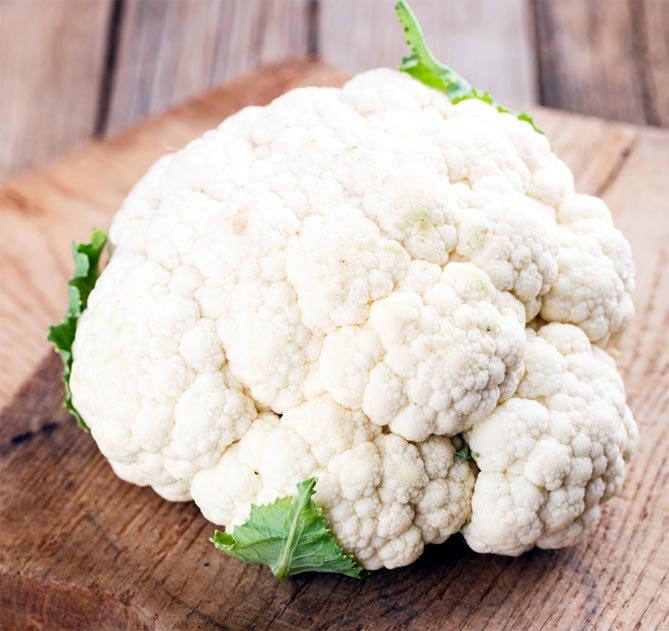

- Express MS - an early variety of cauliflower, heads of cabbage weighing 0.5 kg. Differs in high productivity, loves fertile soil.


Disease and pest control methods
Diseases and pests of ornamental cabbage are absolutely the same as in other cruciferous species. For example, an on-site crop can fall prey to caterpillars, aphids, whiteflies, slugs and cruciferous fleas (Figure 6).


Figure 6. If not properly cared for, the plant can be infested with blackleg or pests
It is imperative to fight these insects, as they not only spoil the appearance of the grown cabbage, but can also infect other crops. To eliminate pests, you can use folk remedies and chemicals.
The same is done with the prevention and treatment of diseases. If the disease has already arisen, they are sprayed with chemicals, and for prevention, the soil and planting material are disinfected, and the bushes themselves are regularly fed to strengthen immunity.
Autumn Potpourri
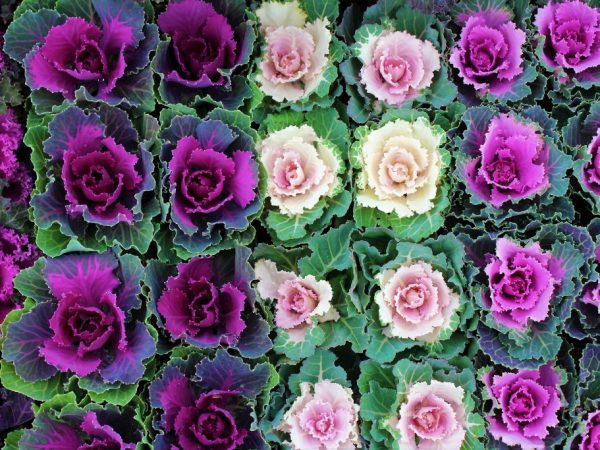

Cabbage is not difficult to care for
From the name of the variety Autumn Potpourri, one can guess that these plants are of various colors. Leaves strongly corrugated at the edges form a rosette in the form of a slightly flattened ball. Low plants (20-25 cm) with a rather loose rosette are 30-35 cm in diameter.
The outer leaves can be herb green or dark green. But the color of the inner leaf plates is much more varied. There are specimens with white, pale pink, raspberry, cream or purple color. Sometimes the wavy edges of the leaf plates are painted in a noble mother-of-pearl. The plant is not resistant to black leg. Watering is carried out as the soil dries up.
When decorating a garden, as a rule, several bushes of ornamental cabbage Autumn Potpourri are planted at the same time.
Stern
By the name of the cabbage variety, one can judge for what purposes it is intended. It is raised for livestock feed. A person's diet is not included, since the leaves are tough and dry in taste. A distinctive feature of the species is the absence of heads of cabbage. It has a powerful rod branching stem (up to 5-6 cm in diameter), expanding at the top. It grows in height from 30 cm to 2 meters. The stem is covered with long lyre-shaped leaves.
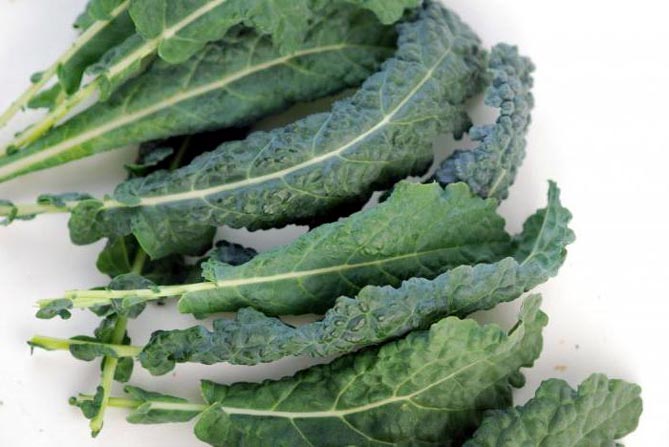

Having considered in detail all possible types of cabbage with visual photos, it is easy to decide what is preferable to grow on your site. This variety allows you to create combined varietal compositions. This will not only decorate the garden, but also provide the family with useful vegetables until next year.
Serenade
Ornamental cabbage Serenade has an unusual shape and is used to create flower arrangements. The edges of its leaves are unusually wavy. All leaf plates are slightly bent inward. In general, the shape of the head of cabbage resembles a slightly flattened ball. In the garden, the plant, whose height is 0.2 m, does not take up much space. The outer leaves are colored deep green. The inner leaf plates can be white, pink or purple. The leaves acquire the brightest color after the onset of the first winter frosts.
This variety of ornamental cabbage is not resistant to black leg. Therefore, it is recommended to grow it in seedlings. Do not overfill young plants. When planting seedlings in the ground, keep in mind that serenade loves light.
This hybrid is not used in cooking. It is prized solely for its decorative qualities.
Distinctive features from other species
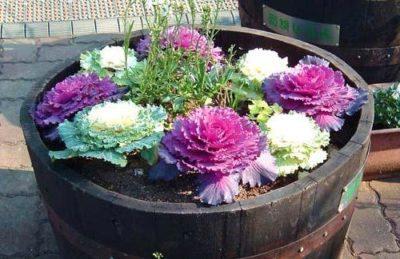

Ornamental cabbage is a member of the Cabbage family formerly called Cruciferous, type of curly cabbage.It has a lot in common with other types of cabbage, but there are also differences:
- only ornamental cabbage is bred mainly to decorate summer cottages and flower beds;
- unlike other species, such cabbage is resistant to cold and even not very severe frosts;
- only ornamental cabbage with blossoming leaves looks like a rose queen of flowers;
- other varieties always have a certain color - green, red, purple, but only a decorative variety can have an unlimited number of colors;
- it has curly leaves, and kale and savoy cabbage, too, but the rest have smooth leaves.
Nagoya F1
Fringed cabbage Nagoya (Nagoya) F1, whose height varies from 10 to 20 cm, has decorative value. She has a dense rosette, consisting of two-color sheet plates (bicolor). Inner leaf plates can be painted in bright yellow, rich crimson or burgundy, purple. The outer leaf plates are always colored deep green. If we compare Nagoya with the similar varieties described above, then it is worth noting that she has most of the sheet plates making up an internal socket. A small amount of leaves corrugated along the edges is colored green.
Planting and leaving
As with all cruciferous crops, planting involves two methods:
For the first method of propagation of Ornamental Cabbage, it is important to prepare the seeds for planting. For seedlings, culture is sown in the second and third decade of March:
- treat seeds with Phytosporin in order to disinfect;
- withstand the seed for a quarter of an hour in hot water, then the same amount in cold water;
- seeds are planted in containers with a loose nutrient mixture with neutral acidity to a depth of 1 cm, watered, covered with glass or other covering material, removed for several days in a shaded place;
- when the first sprouts appear, the seedlings are removed for a week in a cooler place in order to prevent it from being pulled out and for hardening;
- the next 40 days before planting in open ground, the seedlings are provided with warmth and good lighting.
Additional Information: seedlings are not watered often, but they do not allow the soil to dry out completely. The best watering during this period is spraying.
During growth, seedlings are fertilized twice - with nitroammophos when the first true leaf appears, the second time - two weeks before planting in open ground.
For growing ornamental cabbage in a seedless way, it is recommended to prepare the soil in a special way:
- in the fall, superphosphate, ammonium sulfate and potassium chloride are introduced per 1 m 2 in a proportion of 50:20:20 gr. respectively, and 3kg of compost, they dig everything up and cover for the winter;
- at the end of April, small grooves are made in the soil, they are spilled with water and the seeds are placed to a depth of 1 cm, at a distance of 30-40 cm from each other and sprinkled with earth;
- two weeks after the emergence of sprouts, they are fed with nitrogen-phosphorus fertilizers.
Additional Information: Plants tolerate transplanting well from place to place using the transshipment method.
Redhead
Red cabbage owes its name to the unusual color of the heads - red-violet with whitish veins. This species is resistant to heat and low temperatures, prefers an abundance of light and a lot of moisture. When growing in the shade, the heads of cabbage become faded and loose. Red cabbage contains a rich set of nutrients typical of cruciferous vegetables (vitamins A, C, K, B, potassium, calcium, sulfur, phosphorus and magnesium) and anthocyanins, antioxidant colors typical for red vegetables.
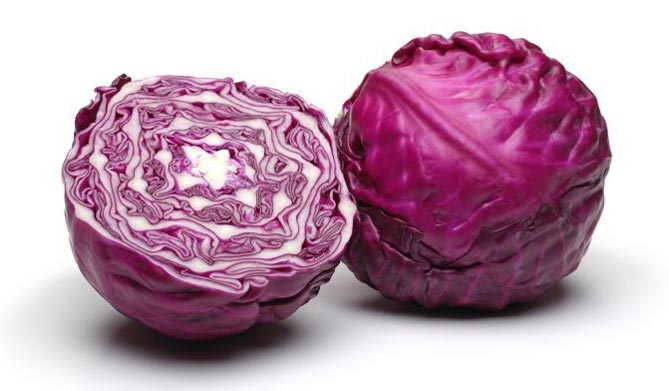

In shape, red cabbage is identical to its white cousin. Heads of cabbage are round or flat-round in shape. Foliage usually begins to tear in the first summer month, without waiting for the full formation of heads of cabbage. As well as the white-headed species, it is divided into early varieties, middle and late ones.The red-headed variety is tasty both after heat treatment and in a fermented state. Late-ripening species have a long shelf life.
The best varieties of red cabbage:
| Early varieties | Mid-late varieties | Late-ripening varieties |
|
|
|
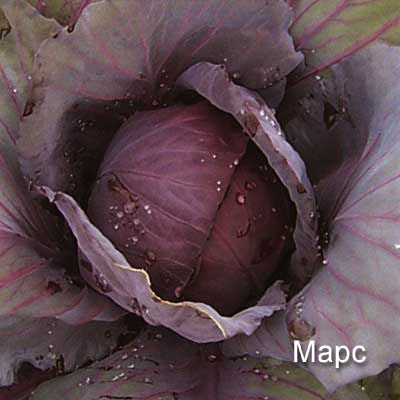

Winter Tale
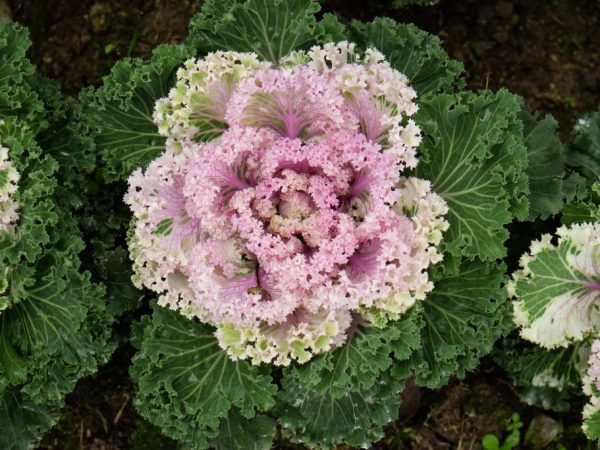

Plants will delight your eyes
Ornamental cabbage Winter's Tale is another type of vegetable crop with lace leaves. The hybrid has a pronounced core, colored crimson or light yellow. The leaf plates of the lower tier can be colored brown or green. From a distance, the heads of cabbage resemble large chrysanthemums. Plant height can reach 0.5 m. The rosette diameter is 30-35 cm.
The Winter's Tale hybrid is frost-resistant. It can be left in the garden until December. The openwork leaf plates sprinkled with snow really look fabulous. A pack usually contains a mixture of seeds that give bushes of different colors.
How to grow beautiful plants for the garden - tips and tricks
Like any plant, ornamental cabbage has its own little growing secrets. A few tips and tricks to help decorate your garden beautifully:
- The culture is propagated by seeds. They can be purchased in the store or obtained after flowering on your site. They do not require soaking, but it is recommended to treat it with a solution of potassium permanganate or any other disinfectant. The cabbage bush blooms in the second year of growth, like a perennial plant.
- If varietal material was purchased for reproduction, you can get high-quality seed from it. If initially a hybrid variety was used during sowing, its offspring will grow, but the desired decorative effect and flowering will not be achieved.
To get a beautiful bush culture, it is recommended to sow seeds for seedlings at the end of March. If you plant in a seedless way, that is, you put seed directly into the ground, the plants will not look so impressive and will be much smaller in size. Unstable spring weather conditions will affect.
An excess of nitrogen fertilizers affects the decorative effect of the crop. The introduction of manure into the soil before planting will have a great effect on the size of the leaves, but the color of the plant will be dominated by green.
Photo
Look further at the photo of the "flower" with the names of its varieties:
Crane
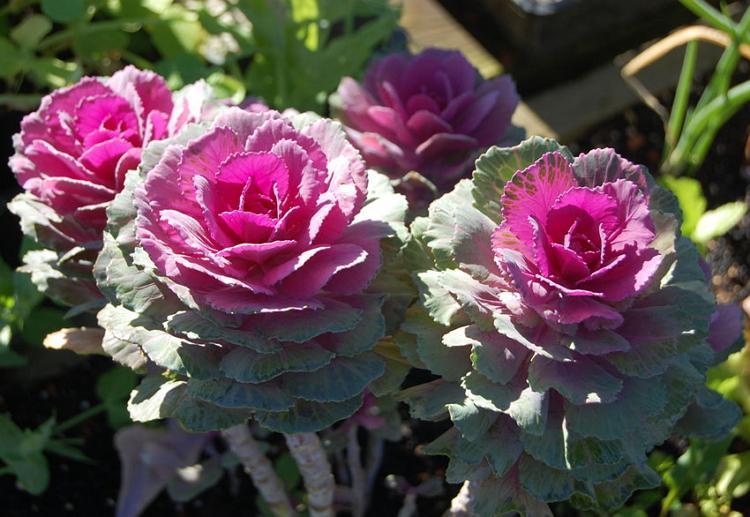

Nagoya
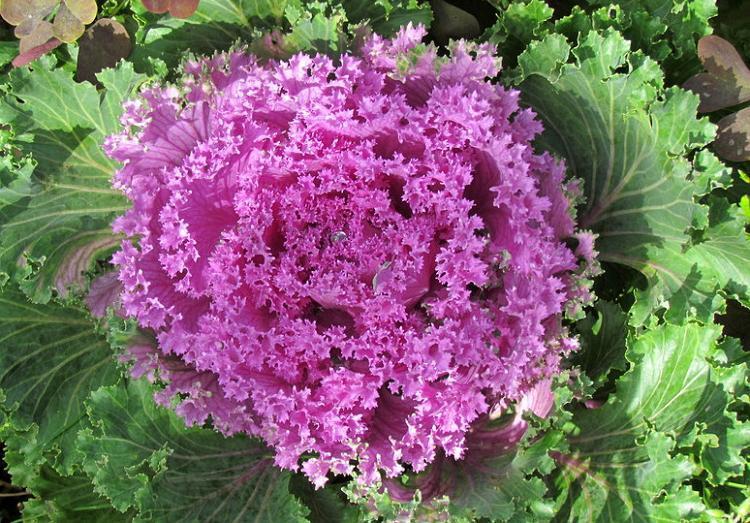

Tokyo
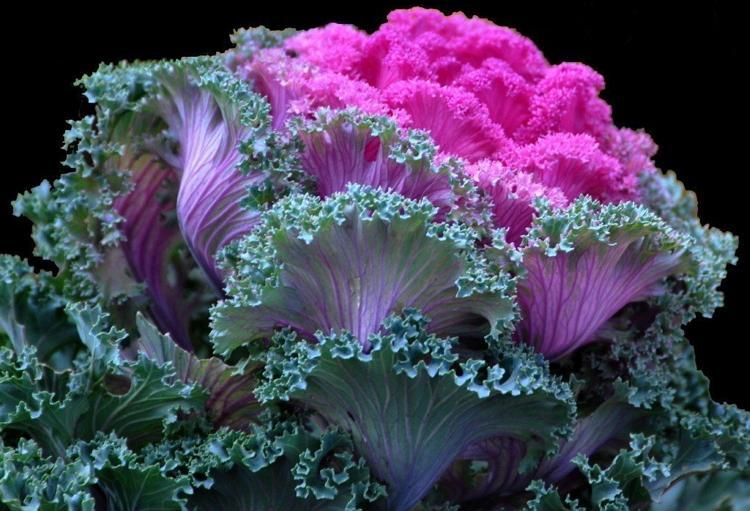

Sunrise
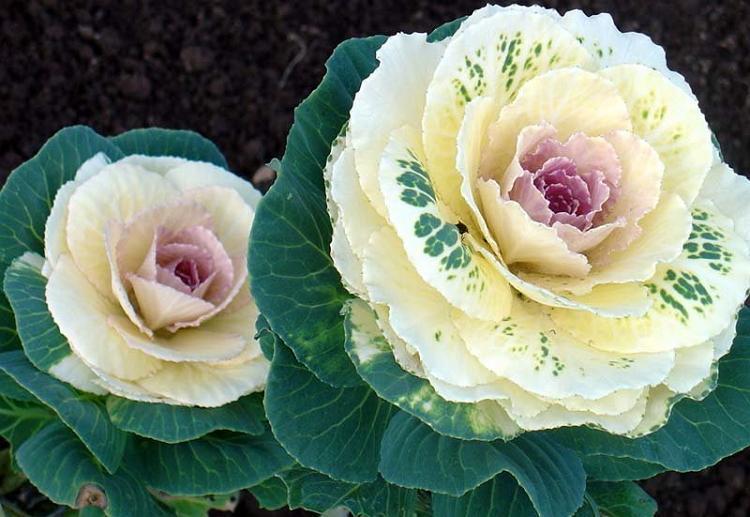

Peacock tail
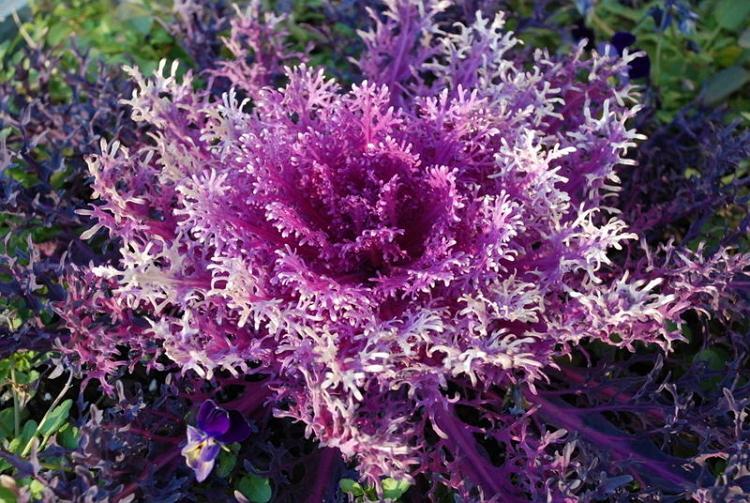

How it grows: in a flowerbed or in a pot
Cauliflower is decorated with perennial beds, the so-called mixborders... By autumn, in such flower beds, many plants have already finished flowering. Perennial grasses (barley, miscanthus, gray fescue), asters, chrysanthemums and annuals that are not afraid of cold weather (cineraria, ageratum, marigolds, amaranth, cellosia) remain decorative. At this time, ornamental cabbage only reveals the full potential of the richness of color and luxurious texture of foliage.
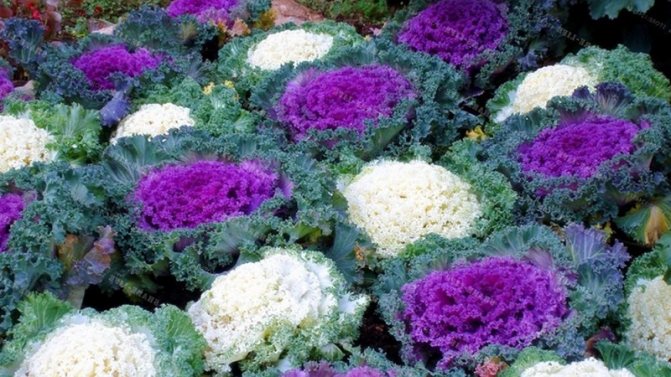

Where and with what plants does the "vegetable rose" look good?:
- As a replacement for bulbous... After the primroses have faded, empty spaces remain in flower beds and flower beds. Loose heads of brassica will close them more economically than other flowers (half the seedlings will be required).
- Single planting on the lawn... Round flower beds from different combined varieties of culture look beautiful.
- Brassica rabat along the garden paths made of wood, stone, gravel, pine cuts or terracotta-colored garden tiles.
- Like a curbframing complex perennial flower beds.
- In openwork flower beds-arabesques... These are carpet flower beds, in which annual plants and ground cover crops are selected of the same height, as well as perennials that endure multiple haircuts.
- Like the original trunk circles... Heading leaves, as they close, completely block the access of light to weeds, in such an elegant near-stem circle moisture remains longer.
The texture of ornamental cabbage leaves is combined with ceramics and wood... Attractive in the garden are flower beds, sheathed with a treated board or small diameter logs.
Attention! Cabbage tolerates multiple transplants, if the root ball does not crumble much during digging.
Varieties that are distinguished by special beauty, unusual shape or size of the head of cabbage, landscape designers recommend planting in separate containers - pots, pots, baskets. In addition, flowering annuals, ground cover and creeping perennials - sedums, ivy, euonymus, can be planted in the pots. When drawing up a complex composition, it is important to ensure that the plants are combined with each other, one culture emphasizes the decorative qualities of the other.
The maximum capacity of such a container is 5-10 liters. Brassica, planted in a container, is convenient to carry to another place.
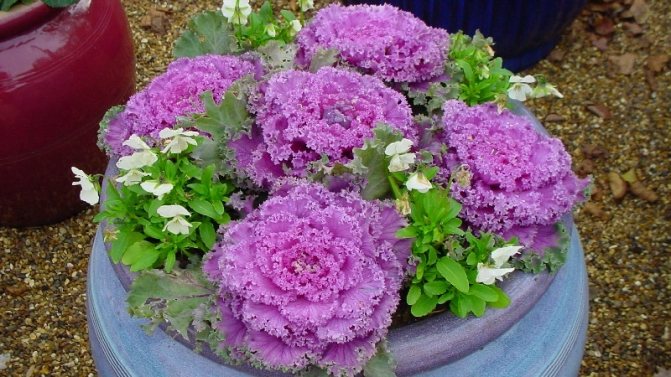

Brussels
A rare species in domestic gardens, but no less valuable in taste and usefulness. The culture is an elongated trunk, along which clusters of miniature emerald-colored heads of cabbage, about 5 cm in diameter, are formed. The taste has pleasant nutty notes. Boiled it is a real delicacy. After boiling, it is also fried. Interesting in pickled form, brussels sprouts are pickled with whole heads.
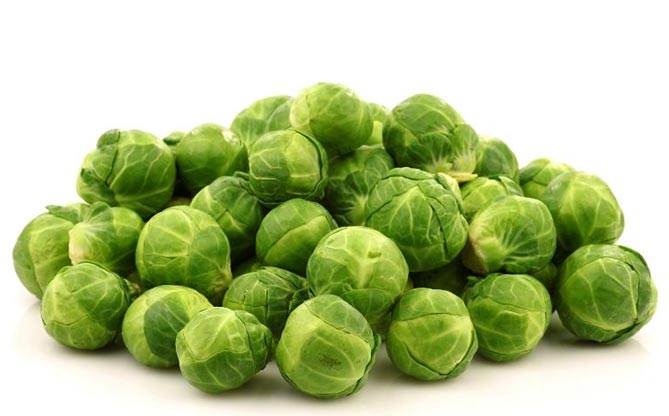

This is the most drought-resistant species. Ripens late (throughout October) - about 170 days pass from sowing to harvest.
Popular varieties of Brussels sprouts:
- Sapphire;
- Hornet;
- Hercules;
- Franklin;
- Rosella;
- Hercules.
The Brussels look is ideally preserved in a cellar or basement throughout the winter. Due to its small size, Brussels sprouts are convenient to freeze.
- Franklin F1 is an early hybrid of Brussels sprouts with high resistance to fusarium wilt.
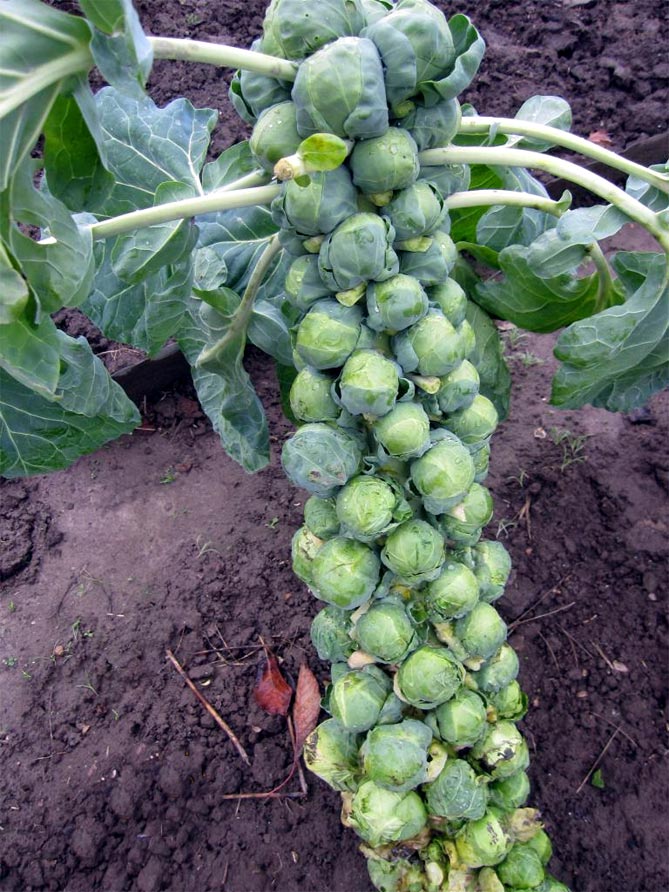

- Sapphire is a medium-ripening variety. Vegetation period: 110-120 days. Forms 30 heads of cabbage, with a total weight of up to 0.5 kg.
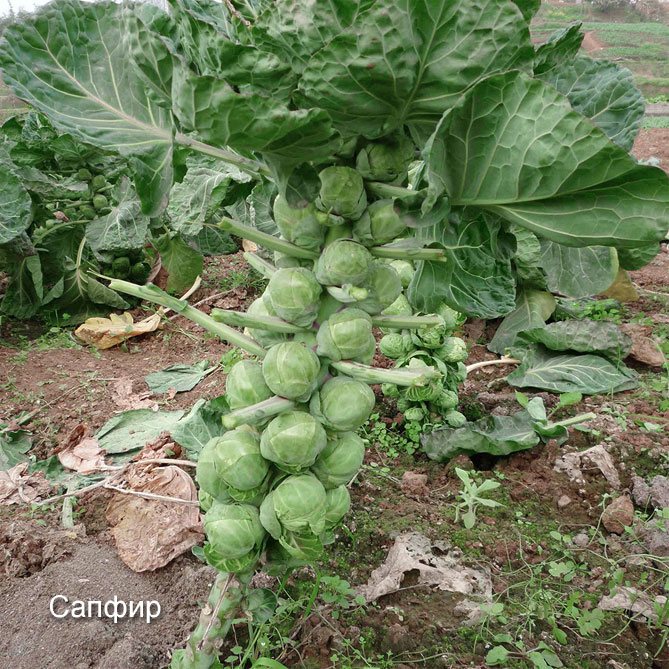

Sheet
The leafy species is also called kale and kale. Today, it is not very popular with gardeners, it is rarely cultivated. When growing, cabbage does not form the usual heads of cabbage - petiolate leaves grow on a thick stem up to a meter high. The color depends on the variety and is different: emerald, silver, red-violet.
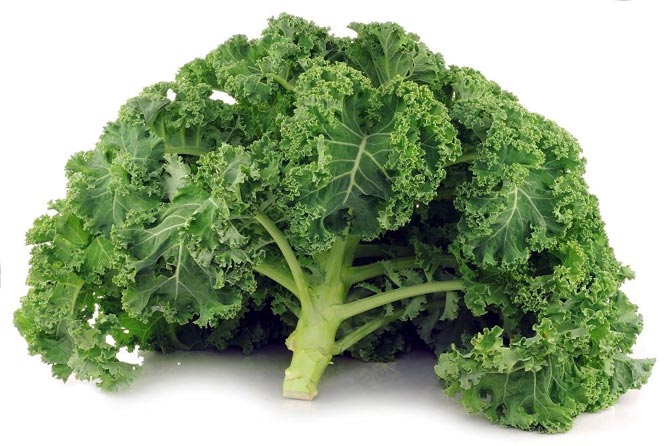

Collard greens are high in potassium. The foliage is added to salads, soups, vegetable stews. After harvesting, cabbage can be stored for a short time, but it is usually frozen for the winter.
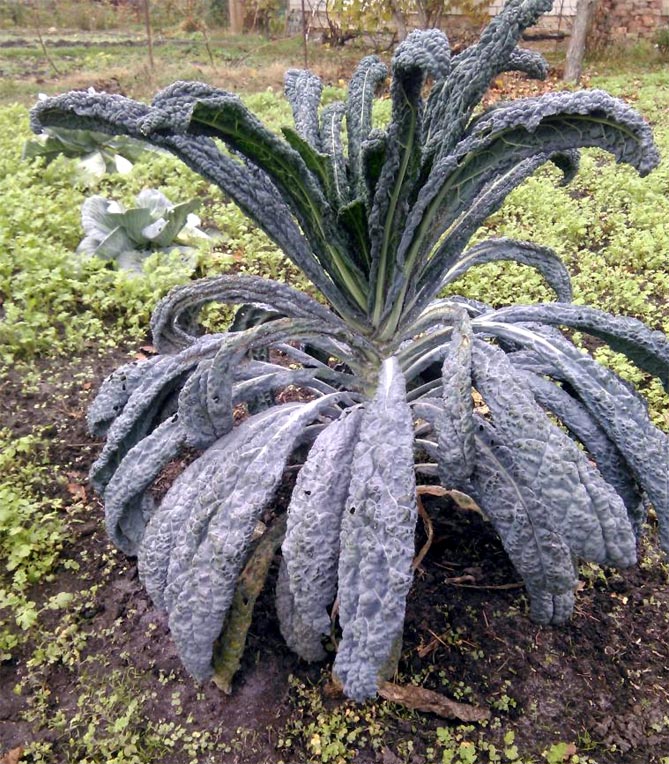

Decorative and nutritious varieties of collard greens:
- Reflex,
- Calais,
- Tintoreto.
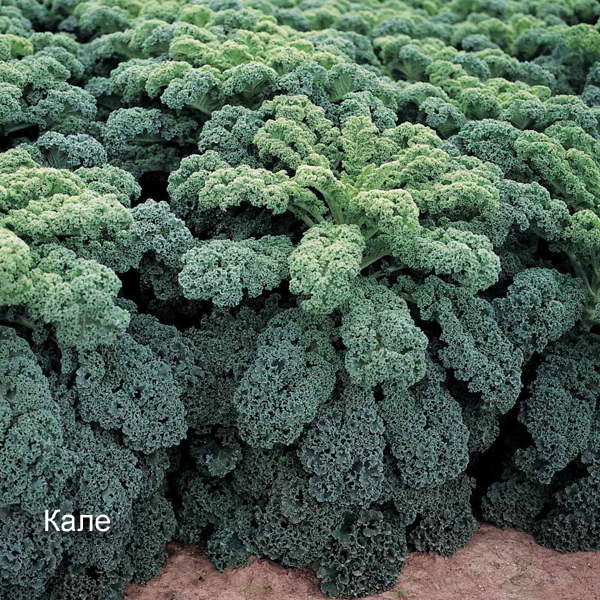

Kohlrabi
An interesting and unusual cabbage in appearance resembling a turnip is a large rounded root vegetable. It also tastes like radish and turnip. The surface color is white, greenish, purple. The pulp is soft and juicy, whitish white. It goes well with any vegetables. Nutritionists recommend this type of use for diabetics. Kohlrabi is rich in vitamin C, fructose, glucose.
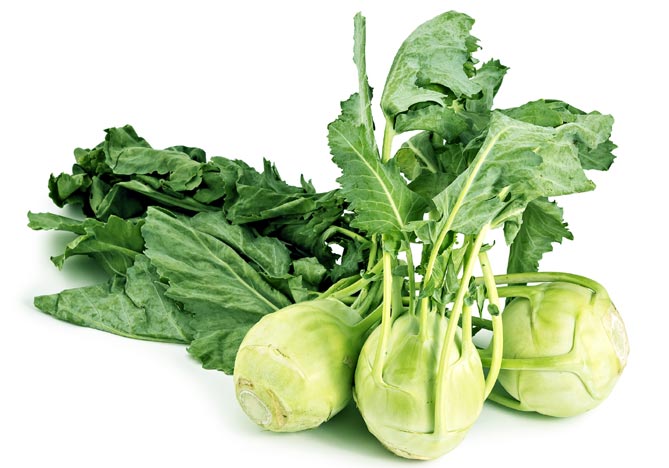

The species is unassuming to grow. No preliminary preparation of seedlings is required - the seeds are immediately sown on the garden bed. During the summer season, such kohlrabi matures twice. After 2 months, the first crop is harvested. The most productive kohlrabi varieties:
- Optimus blue,
- Vienna white woman,
- Koris,
- Giant (late),
- Violett.
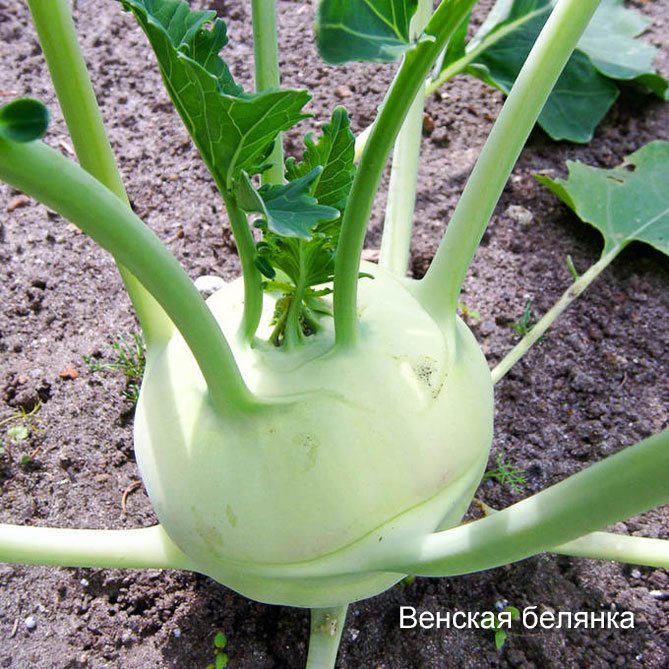

Reflex F1
Reflex F1 is a frost-resistant hybrid of Dutch breeding, which is appreciated not only for its decorative qualities, but also for its taste. Oblong, highly corrugated, erect leaves do not form a rosette. The plant reaches a height of 0.8 m.
Green leaf plates are extremely rich in trace elements and vitamins. Sometimes there is bitterness in them, which can be removed by freezing.
Kale cabbage, which is widely used in cooking, looks similar.
Nimble Turtle
In appearance, the Shustraya Turtle variety differs from all of the above. It has a conical shape, and small inflorescences, painted in light green color, form miniature domes. Dark green narrow leaf plates are located around the rosette of an unusual shape.
Use the Nimble Turtle to decorate gardens. Using this plant, it is convenient to create geometric shapes or ornaments. A feature of this variety is its resistance to severe frosts. But this temperature is fatal for young plants. The permissible minimum for immature ornamental bushes is -40.
Advantages and disadvantages
The advantages of brassica can be considered:
- aesthetics and decorativeness;
- the length of the season;
- a huge number of different types;
- resistance to cold, even to frost down to -12 ° С;
- growing with seeds or seedlings;
- unpretentious cultivation;
- disease resistance;
- the ability to transplant;
- versatility in use as an edible vegetable and ornamental plant for decoration.
The disadvantages of the plant can be considered:
- coarser leaves compared to white cabbage;
- the leaves are slightly bitter until they are frozen;
- thorough care;
- before the cold weather does not look too beautiful.
Chinese - Pak-choi
Cabbage, similar to the Peking variety, has a compacted rosette of leaves that grow scattered without forming a single head of cabbage. It is a species especially beloved in Asia. It consists of medium-sized, smooth, elongated leaves that are green with white tips. Both the white and green parts of the leaves are edible, but remember that the smaller the leaves, the tastier they are. This species is characterized by a high content of B vitamins, vitamins C and iron.
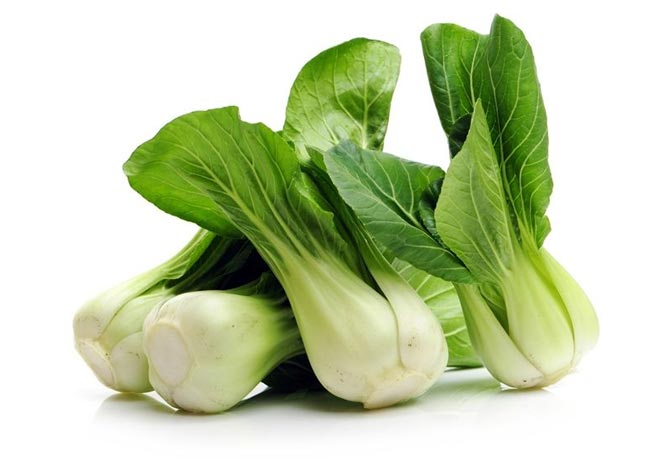

The variety is unpretentious in care, it grows successfully even on poor soil. In cooking, it is common as a vitamin supplement in salads. Works well as an ingredient in soup and as an addition to meat and fish dishes. In China, this vegetable is considered a source of long youth and excellent health.
There are many varieties, the most famous are:
- Swallow,
- Chill
- Alyonushka,
- Peahen.
